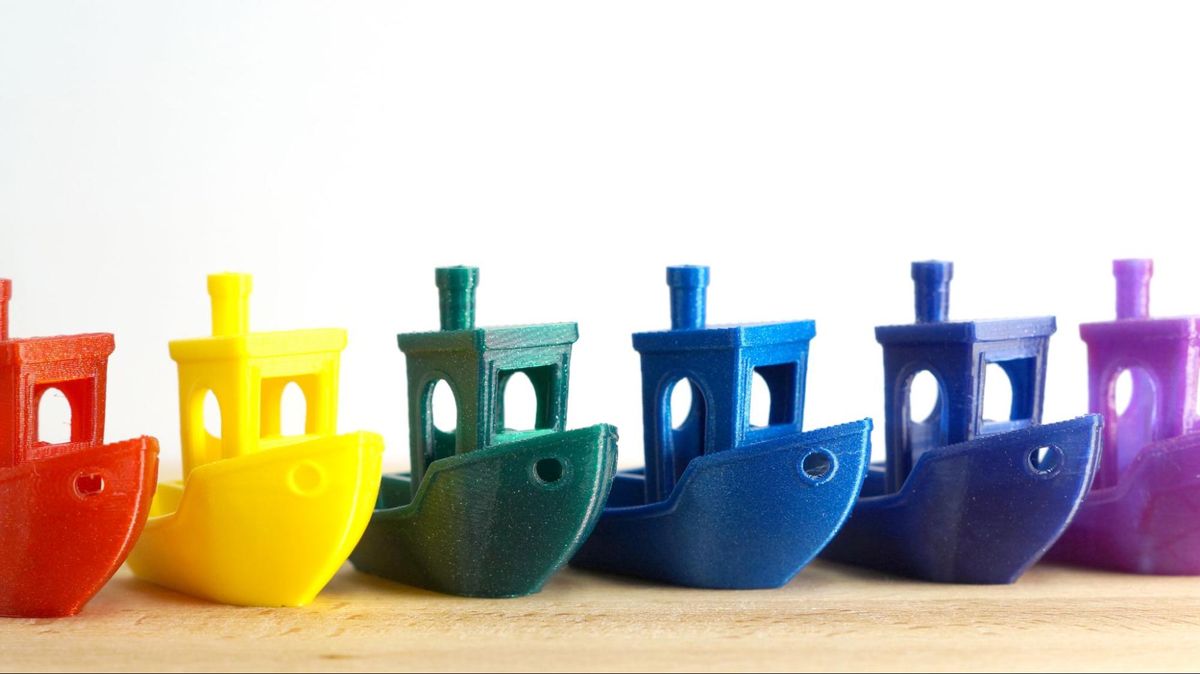If you’re printing with an FDM-style 3D printer (the most popular and user-friendly type), your printer feeds a roll of plastic (or other material) filament through a hot extruder and then deposits it on the print bed in layers. You can have one of the best 3D printers or the best budget 3D printers on the market, use all the right settings in your slicer, and still end up with a print failure or ugly output if you don’t use the right filament.
The best filaments for 3D printing can not only provide good adhesion and avoid clogging your extruder but also build models with eye-popping colors, sharp details, and strong durability. Filament rolls are available in a virtually limitless array of different colors, including rainbow and translucent.
3D Printing News: The top players in 3D printing manufacturing, including filament makers like Polymaker, turned out at this year’s Rapid + TCT event held in Los Angeles on June 25th – 27th to show off their latest and greatest products, and we were there to cover it. Read more
We’ve burned through cases of filament on dozens of printers using both Bowden and direct drive extruders to help you find the best filaments for 3D printing in the form of PLA, PETG, and TPU materials. A summary of our picks is below, followed by a detailed list with photos and specs for each recommended filament.
Best Filaments At A Glance
Filament Types
There are many different materials — mostly types of plastic — that you can get, but there are three major varieties.
PLA (Polyactic Acid), also sometimes combined with other materials and called PLA Plus, is the easiest to print with and most popular, but it isn’t the strongest, and it can be brittle.PETG (Polyethylene Terephthalate modified by Glycol) is stronger and a bit more flexible, but it can be stringy if you don’t dial in your settings correctly.TPU (Thermoplastic Polyurethane) is a rubbery, flexible filament that usually requires a direct-drive printer that can hit high temperatures. Best PLA Filaments
The best filament type for most people and projects, PLA (polyactic acid) is usually inexpensive and easy to print, which is why it’s also the most popular material. PLA filament runs on any 3D printer with any kind of bed surface and doesn’t require an enclosure. Made from renewable organic sources like corn, beets or sugarcane, PLA is more environmentally friendly than oil based plastics and doesn’t have very harsh fumes.
Most PLA is somewhat brittle and has a low melting point, so it’s best used for decorative objects not subject to high temperatures or too much sunlight. It sands well and is easy to paint, making it great for costume pieces.
Nozzle Flexi Toy by CM Design, printed in with a Sovol SV07 using JAYO PLA Plus.
Looking for a bargain? JAYO has you covered with easy printing and affordable PLA Plus. PLA Plus is stronger than normal PLA, and can be used in practical prints that aren’t exposed to high temperatures or let sitting outside – like toys and storage boxes. This giant nozzle was used to test a Sovol SV07 running Klipper and was printed at a brisk 250 mm/s without issue.
The spool was neatly wound on recycled cardboard, with a pair of holes punched in the side of the spool makes it easy to tuck away the loose ends of your filament.
Buy: JAYO PLA Plus
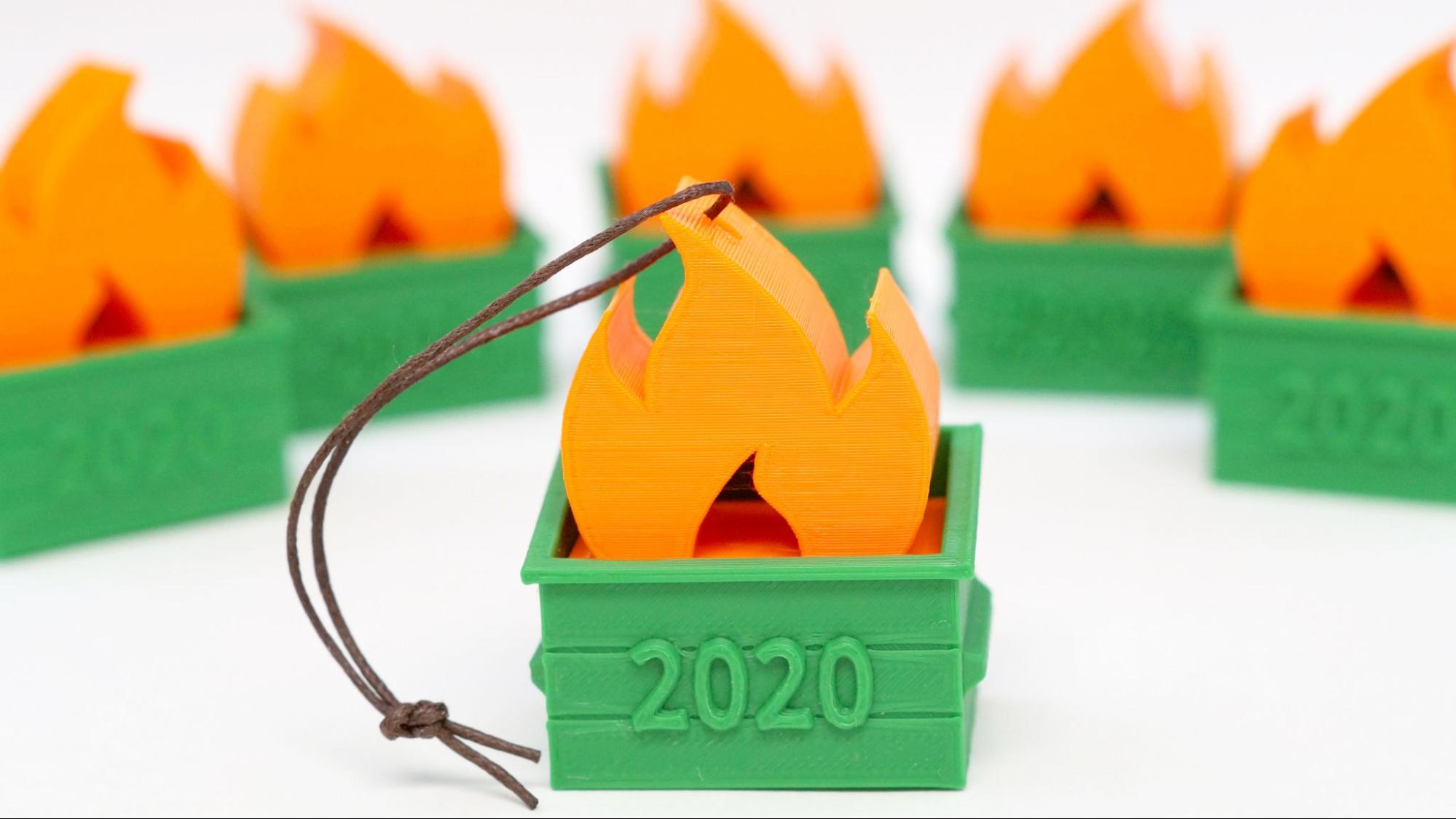
OG Dumpster Fire Ornament, by Denise Bertacchi, printed with an Ender 3 Pro with Jessie Premium PLA Tree Green and Mystery Orange.
Jessie Premium PLA is a smooth printing filament manufactured by Printed Solid in Newark, DE. I’ve been a big fan ever since the Dumpster Fire incident of 2020 when I printed hundreds of Dumpster Fire Christmas ornaments for friends and family in Jessie’s Tree Green and Mystery Orange.
You can select from a palette of 38 colors, each packaged on sturdy cardboard spools with steel cores for a friction free spin. Care for sparkles? Filament with micro glitter is only a dollar more than the regular versions. Spools are well labeled and made of sturdy chipboard with a steel core that helps lower friction while still being fully recyclable. Fun fact: the Jessie line is named after CEO David Randolph’s dog.
Buy: Jessie Premium PLA Filament
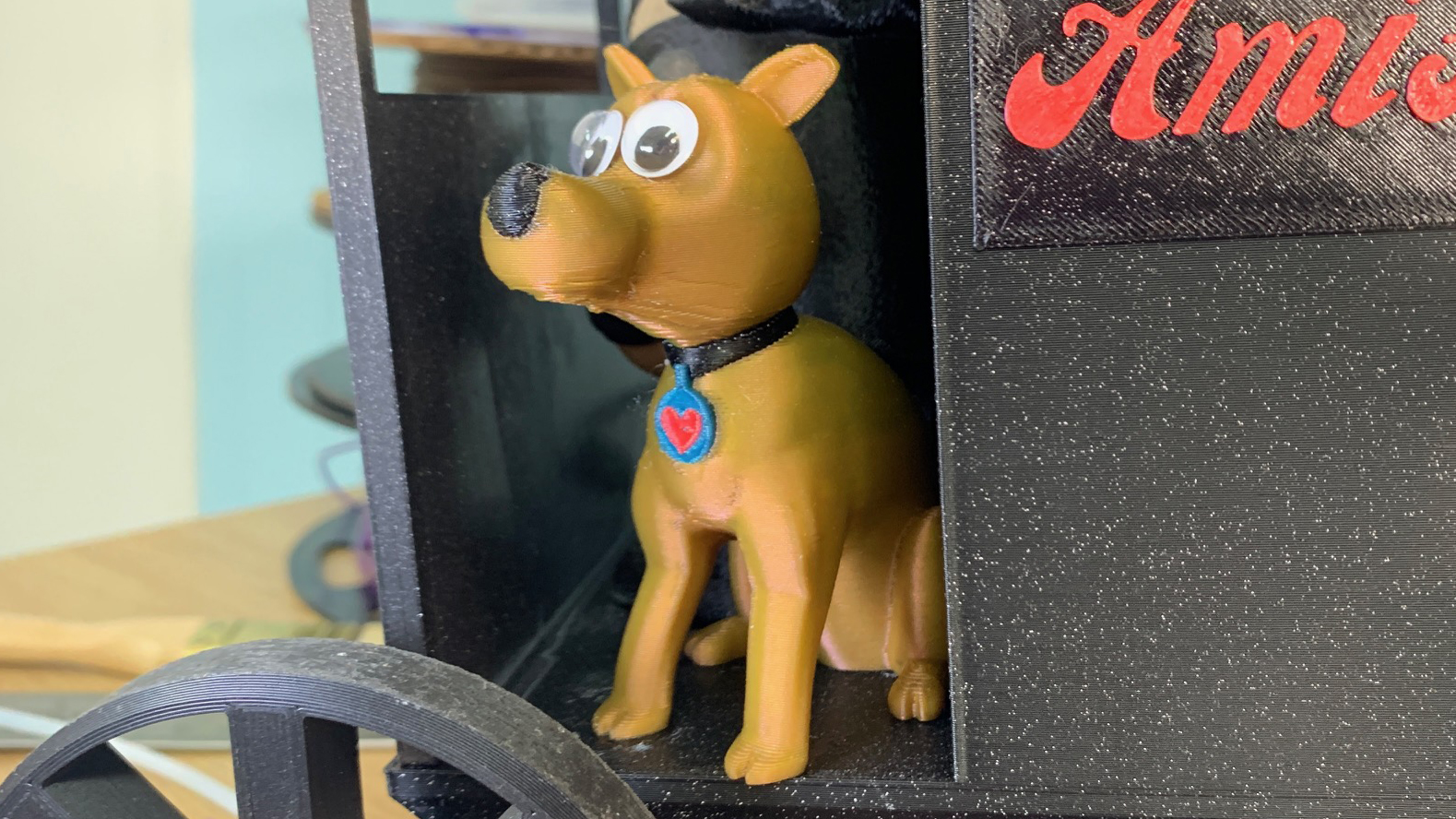
Rudoph Snowdog by Bugman 140’s, slightly modded. Printed on a Bambu Lab P1P in Polymaker Starlight Jupiter.
Announced this year at the Rocky Mountain RepRap Festival, the Starlight series of Polymaker filament is an eye-popping line of shimmery metallics. The filaments have a color shifting property that makes their colors hard to peg down, but have a lush metal tone. The glitter is very finely ground to avoid being too abrasive on your hotend.
Polymaker spools are always neatly wound on recycled cardboard, with a several well spaced holes punched in the side of the spool makes it easy to tuck away the loose ends of your filament.
Buy: Polymaker PolyLite Starlight
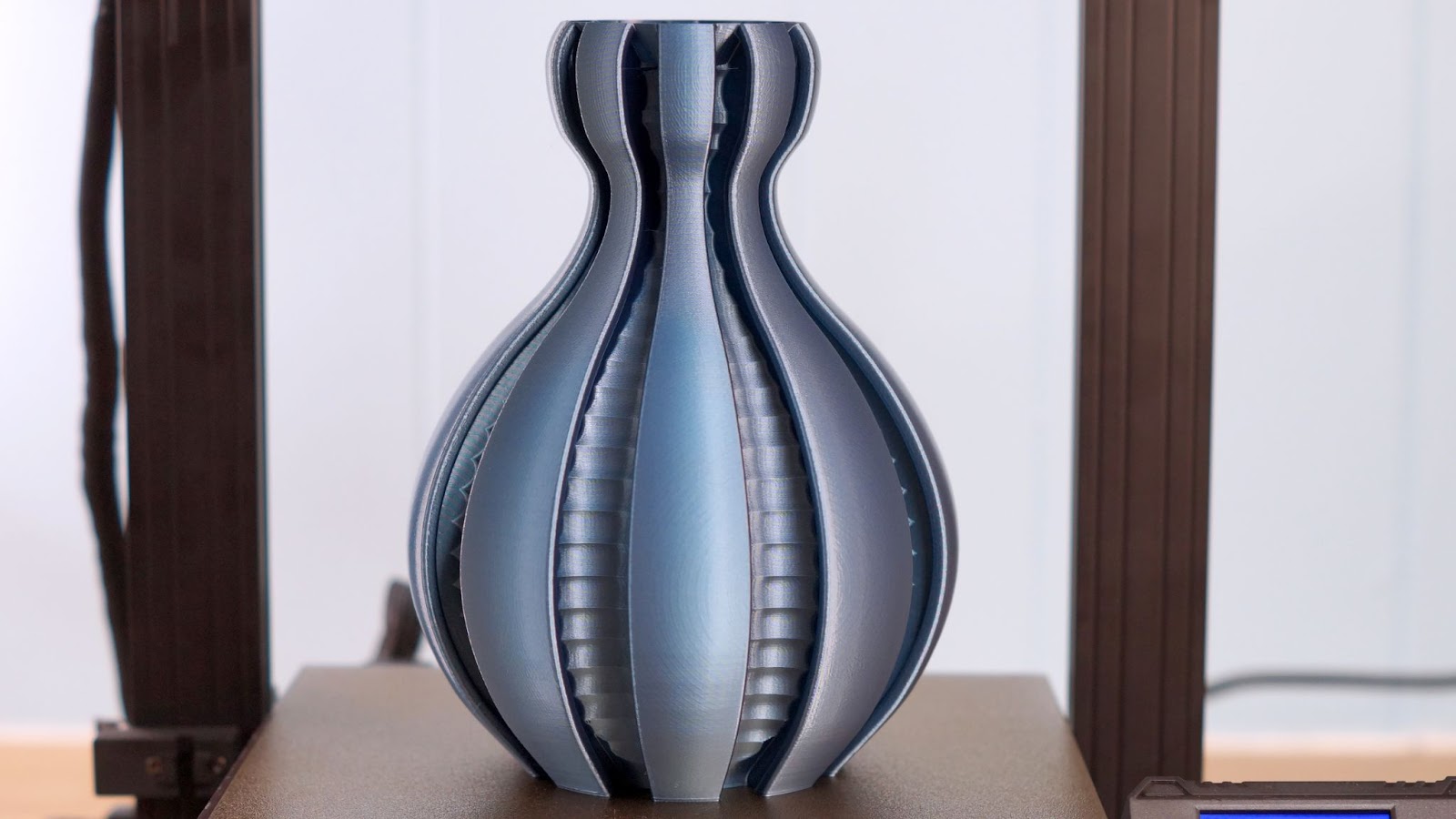
Clockspring’s Illusionist Vase by Clockspring3D printed with an Anycubic Kobra Go with Anycubic’s Metal BluePLA.
Anycubic has introduced a line of filament to accompany their printers, starting with a pallet of basic colors. One stands out though: Blue Metal, a beautiful silk PLA with an interesting luster that shifts the filament from blue to steel gray. The material prints smoothly and does a great job of hiding layer lines.
Anycubic’s filament prints well on all FDM printers. The spools are made of dense cardboard with holes for tucking the end of your filament, though there’s practically no labeling.
Buy: Anycubic Blue Metal
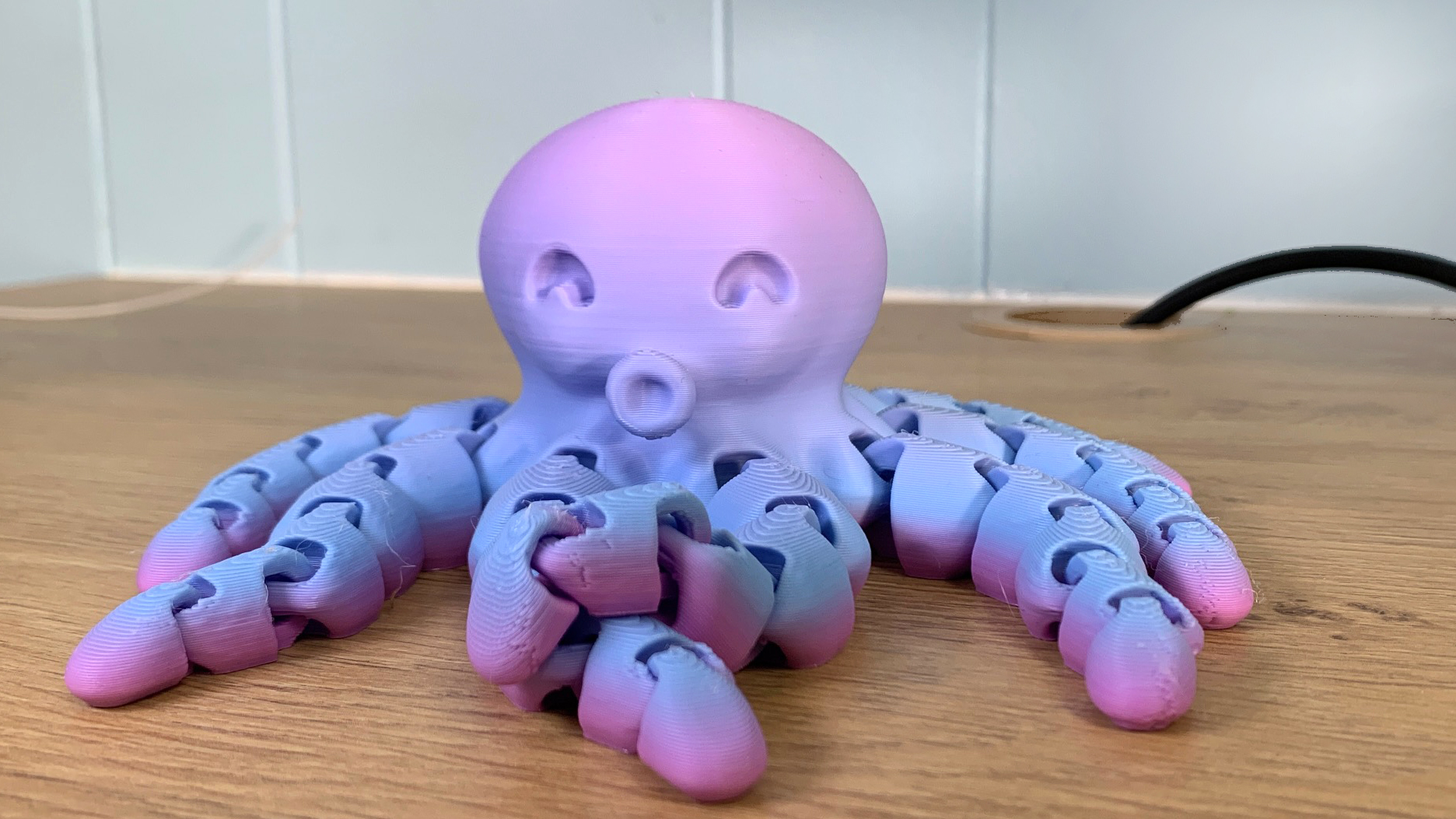
Cute Mini Octopus by McGybeer printed on a FLSun V400 with Cookie Cad Unicorn PLA.
Cookie Cad makes some amazing colors, and their gradient blends are among our favorites. Gradients slowly blend complmentary colors together, similar to a rainbow PLA, but with only three colors. Mermaid is Purple – Blue – Green, Unicorn is Pink – Blue – Purple, Sunrise is Pink – Orange – Yellow and Sunset is Dark Blue – Purple – Pink.
Cookie Cad’s gradient blends are perfect for making dragons and other decorate containers where a slow color shift can be optimized.
Buy: Cookie Cad Gradient PLA
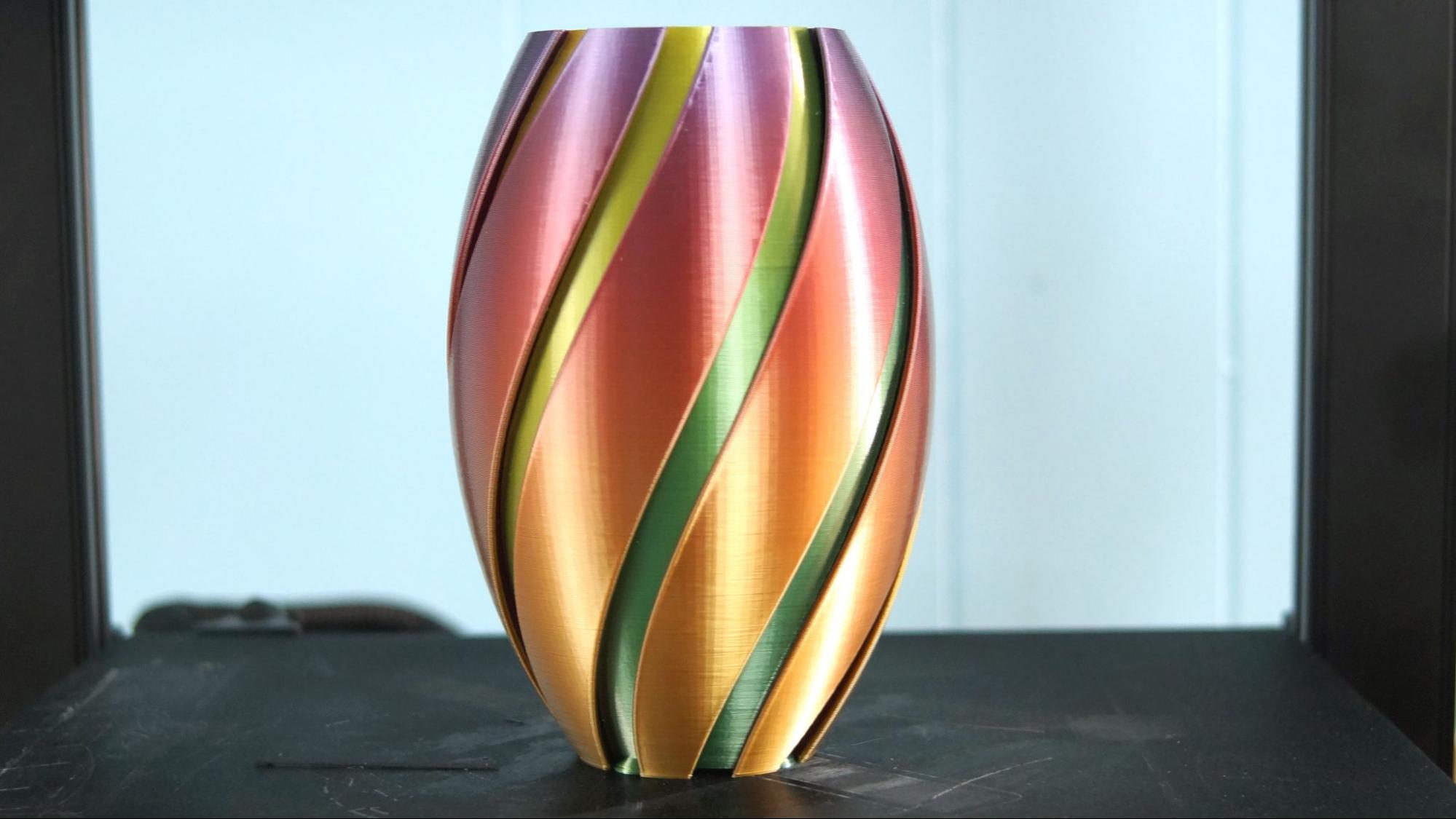
Correlation Vase by Clockspring3d on a Sovol SV01 Pro in MIKA3D Silk Rainbow
This super fast, silk rainbow PLA only needs about 5 meters per color change – a third less than other brands. Still, that’s a lot of filament, and this Correlation Vase from Clockspring3d’s Patreon only shifted through three of its delicious dark metallic colors.
Mika3D sells this color in three batches of 500g spools, leaving you with awkward amounts of filament at the ends of each spool. The spools are well labeled, but are plastic, which causes unneeded waste.
Buy: Silk Rainbow PLA Filament
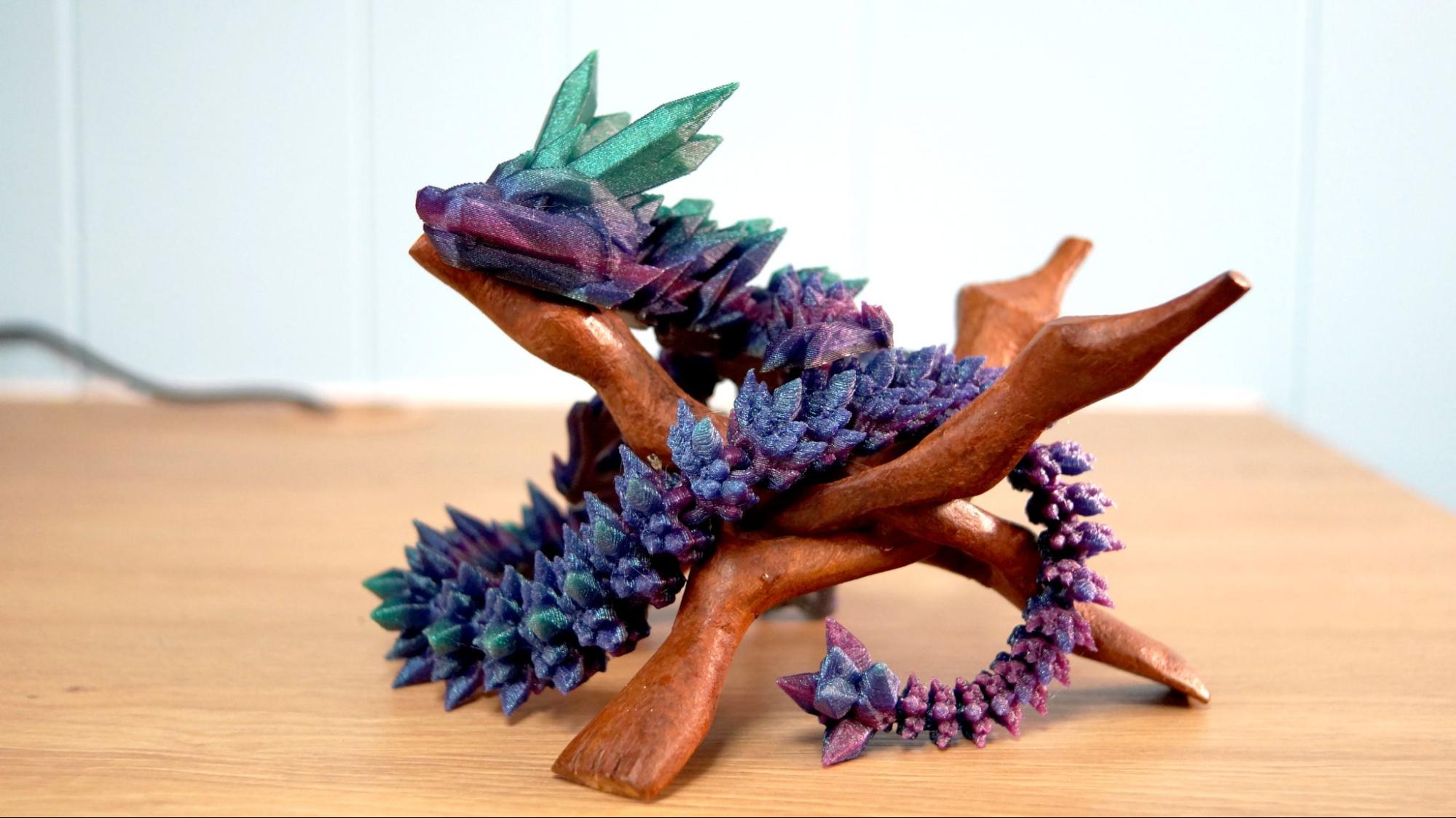
Crystal Dragon by Cinderwing3D, printed on a Lulzbot Sidekick 747 in Locyfens Blue/Purple/Green Rainbow PLA.
This line of glittery rainbow PLAs make super fun prints that transition through 3 to 5 colors, depending on which version you purchase. The shimmery additive is non-abrasive and makes layer lines melt away for extra smooth prints. As with most rainbow filaments, you’ll need to use a lot of filament to see the color changes. It takes about 15 METERS between colors. This Crystal Dragon took over 56 meters of filament and just got into the third color of a Blue/Purple/Green spool.
Locyfens uses clear plastic spools, which is nice for seeing how much filament is left on the reel, but inconvenient once the filament finished. They are well labeled and have good spots for managing the filament tails.
Buy: Locyfens Rainbow PLA Filament
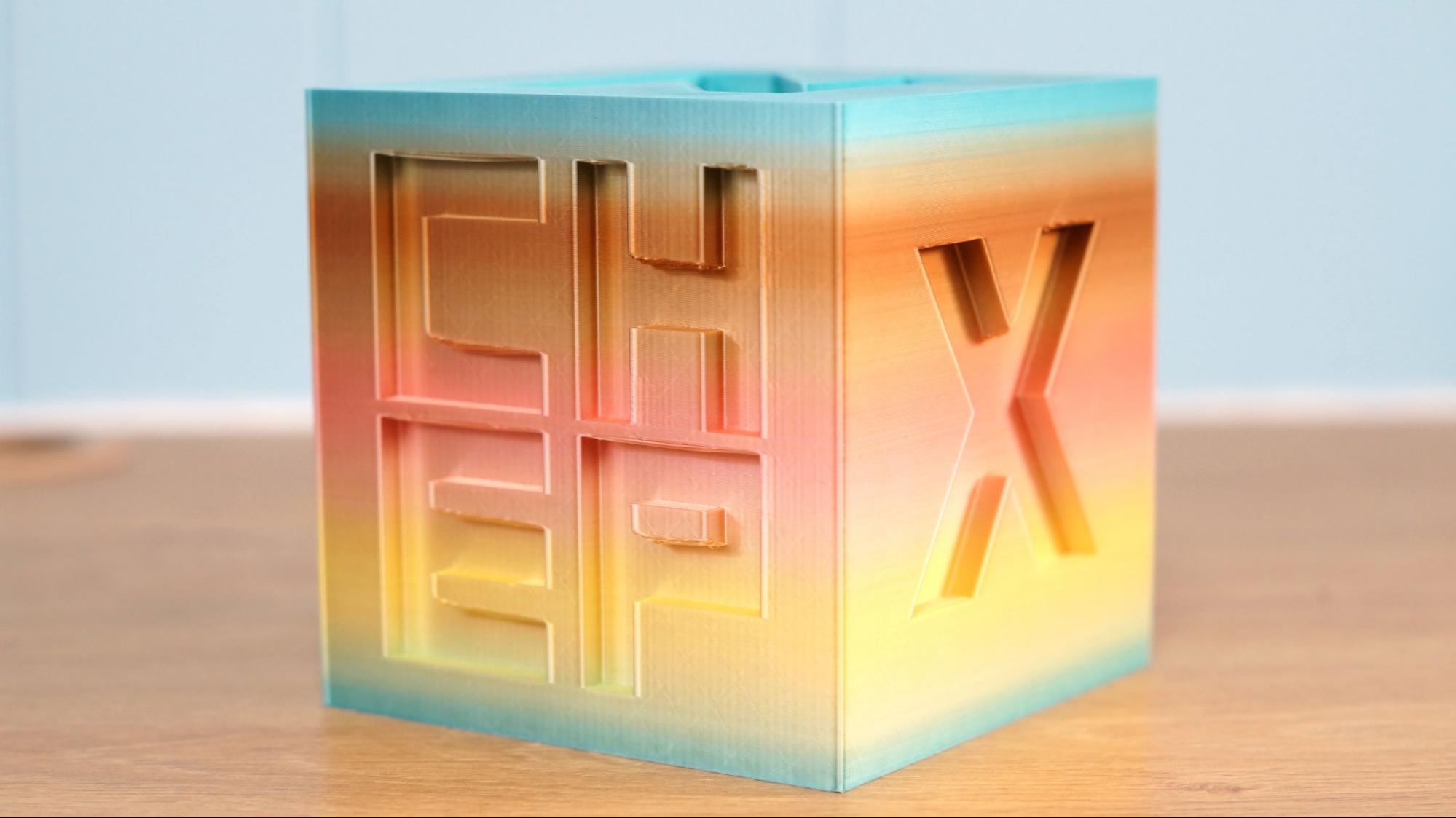
CHEP Cube by Chuck Hellebuyck, printed on the CR10s with Inland Rainbow 2 PLA.
Inland makes three Rainbow filaments: Silk Rainbow, a pastel Rainbow 2 shown here, and glow in the dark Luminous Rainbow. Each filament uses Inland PLA as the base. As with most rainbow filaments, you’ll need to use a lot of plastic to get several color changes.
It takes about 15 meters between colors. This CHEP Cube was printed at 600% with thick walls and weighs about 300 grams and just barely makes it through all the colors in a spool of Rainbow 2. Inland’s rainbow filaments are currently spooled onto clear plastic master spools – which means they can be refilled with Inland Spooless once they are used up.
Buy: Inland Rainbow 2 Silk PLA Filament
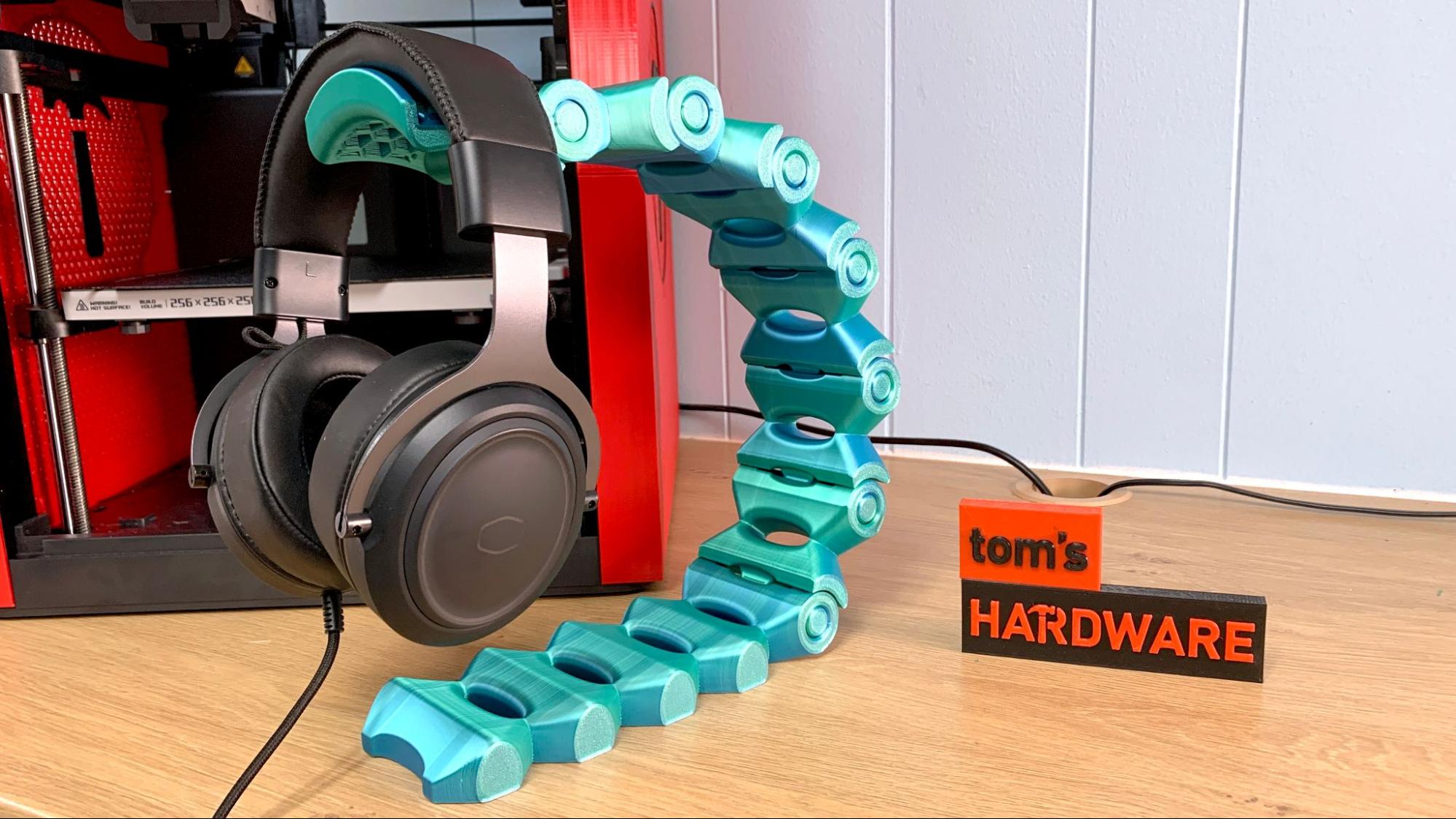
Vertebranium Headphone Stand by Clockspring printed on a Bambu Lab P1P in Blue/Green Silk PLA from Inland.
Inland jumped into the dual color game with it’s own line of silk PLAs. Inland’s dual colors mix more than other brands, so the color shift is more subtle, like mixing pastels chalks.
Inland’s two color silks comes in 10 color combinations. A direct drive extruder handles it better, though Inland seems to twist less in the extruder and produces an even effect.
Buy: Inland Dual Color Silk PLA
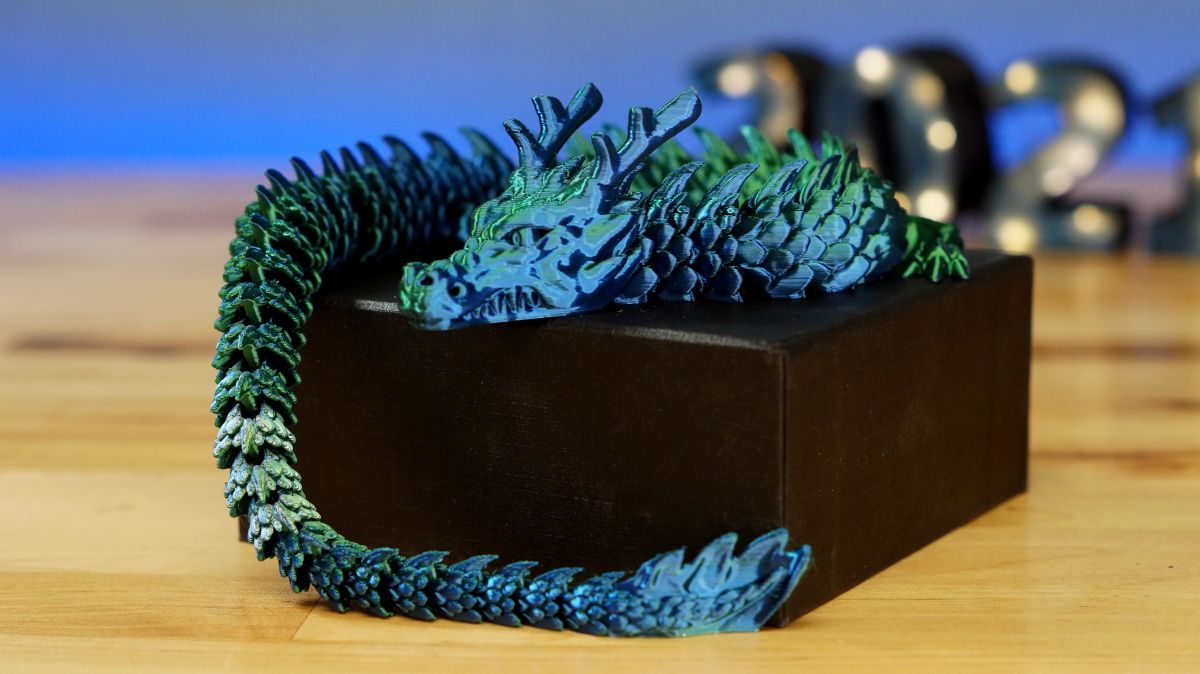
Articulated Dragon by McGybeer, printed on the Ender 3 Pro in MH Blue Green Quantum.
Is it blue or is it green? It’s both! Matterhackers was the first company to introduce the 3D printing community to dual color filament – filament that has two colors running side by side on a single strand of plastic. The colors do an interesting dance that causes color shifts depending on your viewing angle.
Quantum is a silk PLA that comes in 12 color combinations. It works best on a direct drive extruder, which keeps the filament from twisting on its way to the hotend. Quantum is delivered on well labeled plastic spools, which are great for seeing how much filament is left on your spool, but leaves you in a trash quandary when the filament is used up.
Buy: MatterHackers Quantum PLA Filament
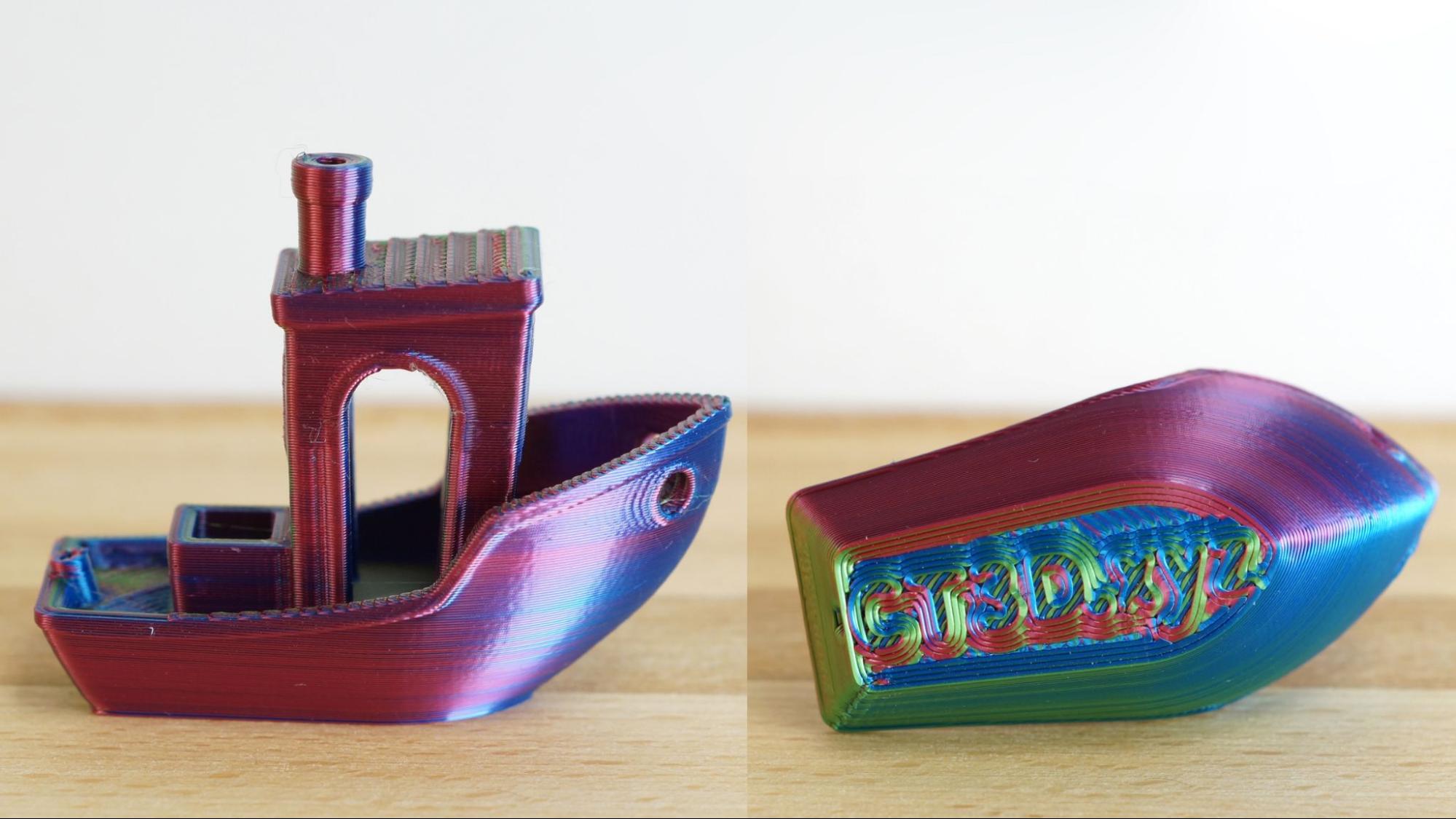
3DBenchy by Creative Tools. Printed on Lulzbot Sidekick 747 in OVV3D Red/Blue/Green Tri-Color Shiny Silk PLA.
You’ve seen dual color filament – now you can print THREE colors all at once. Tri-color filament has three colors running side by side by side on a single strand of plastic. This results in a shimmering, almost iridescent shine as the three colors mix.
Tricolor is a silk PLA at its heart, and runs better when hot. It also benefits from the straight path of a direct drive extruder, which keeps the filament from twisting on its way to the hotend. OVV3D delivers its filament on well-marked, heavy chipboard spools that can be recycled.
Buy: OVV3D Tri-Color Shiny Silk PLA Filament
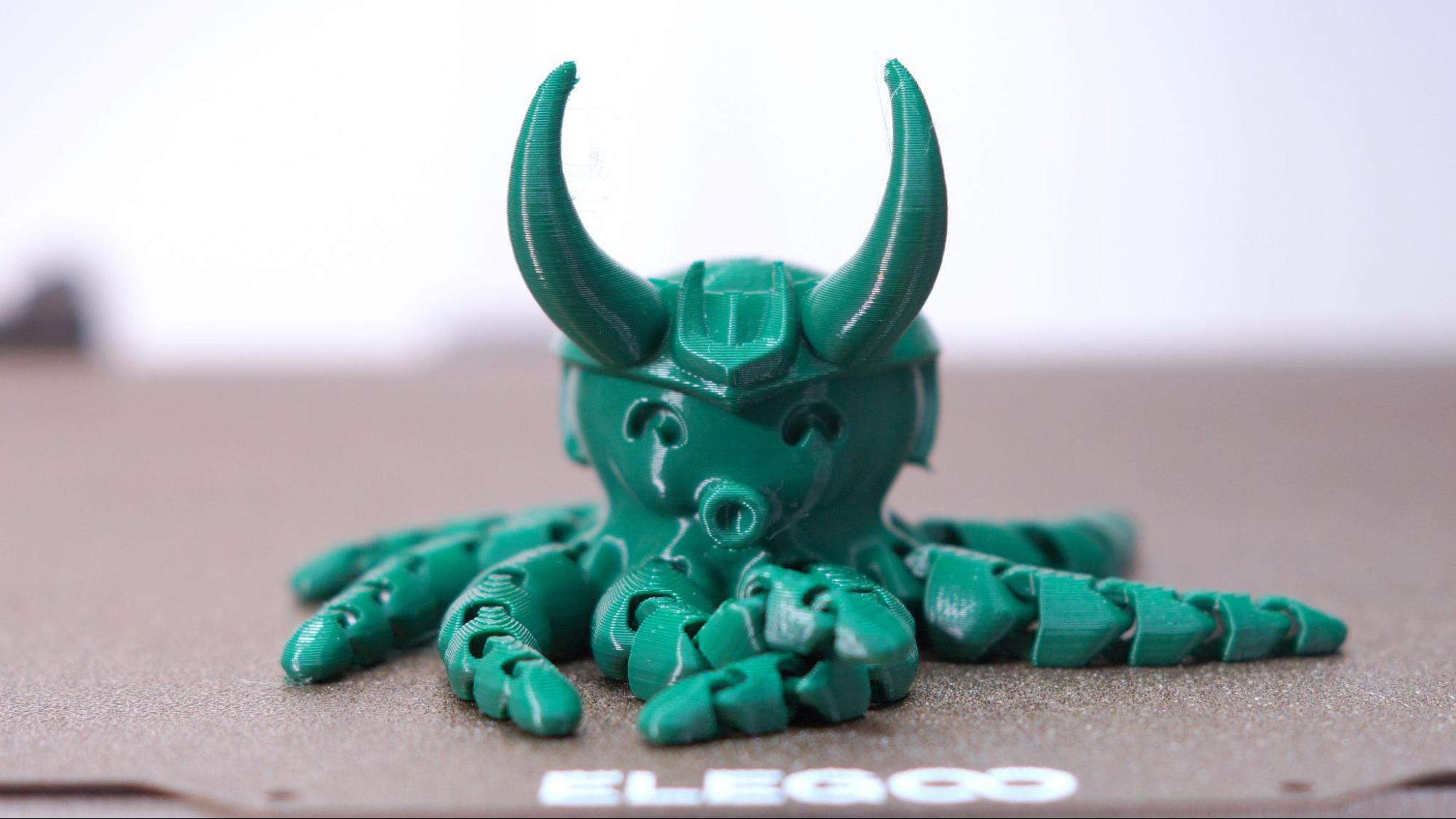
Octo-Loki by McGybeer, printed with an Elegoo Neptune 2s, using MH Build Forest Green PLA.
MH Build Series is an affordable line of easy printing PLA in 19 bold opaque colors for everyday use and prototyping. No frills or glitter here, just consistent material to keep your printers chugging along. This Octo-Loki looks super clean in Forest Green PLA.
MH Build Series comes on plastic spools labeled with suggested printing temperatures and convenient holes for threading the loose ends of your filament to keep the spool tidy.
Buy: MH Build Series PLA Filament
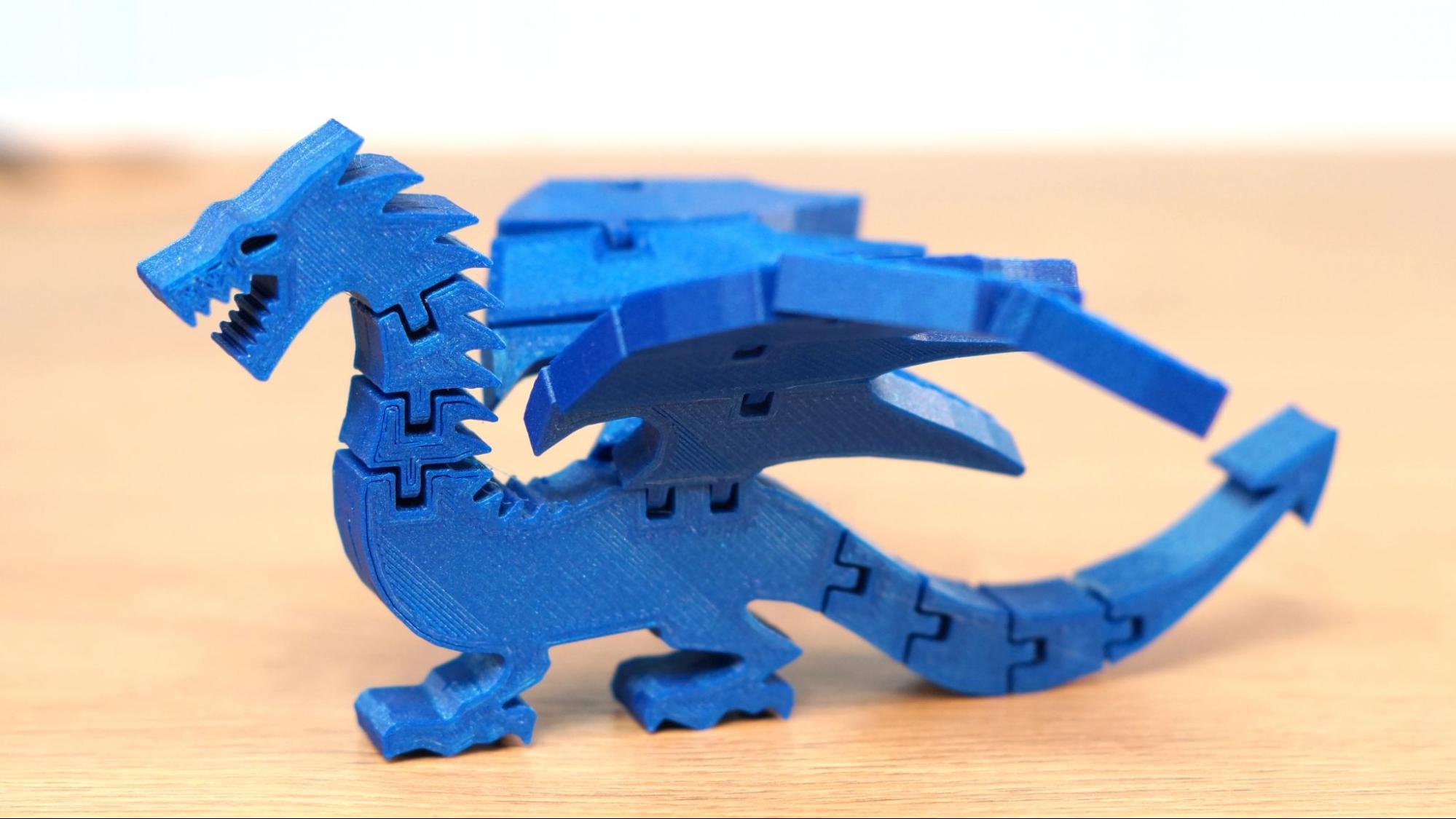
Two Winged Flexi Dragon by TheBeyonder, printed on a CR10s in Protopasta HTPLA Joel’s Highfive Blue.
Protopasta HTPLA is one of my favorite materials for 3D printing – it always runs smooth, trouble- free and without obvious layer lines. Sparkly colors use extremely fine micro glitters to avoid being abrasive to your nozzle. Even better, many of their specialty colors are concocted by visitors to the factory’s Filament Making Workshops. This dragon flexi was printed in my favorite color, Joel’s Highfive Blue.
There’s 22 Community Inspired Colors, which have always been spooled on 100% recyclable cardboard. The spools are well labeled, but they lack holes for tucking in the tail of filament – we’ve used tape or simply jabbed the end into the spaces in the corrugated cardboard. Manufactured in Vancouver, WA.
Buy: HTPLA Protopasta PLA Filament
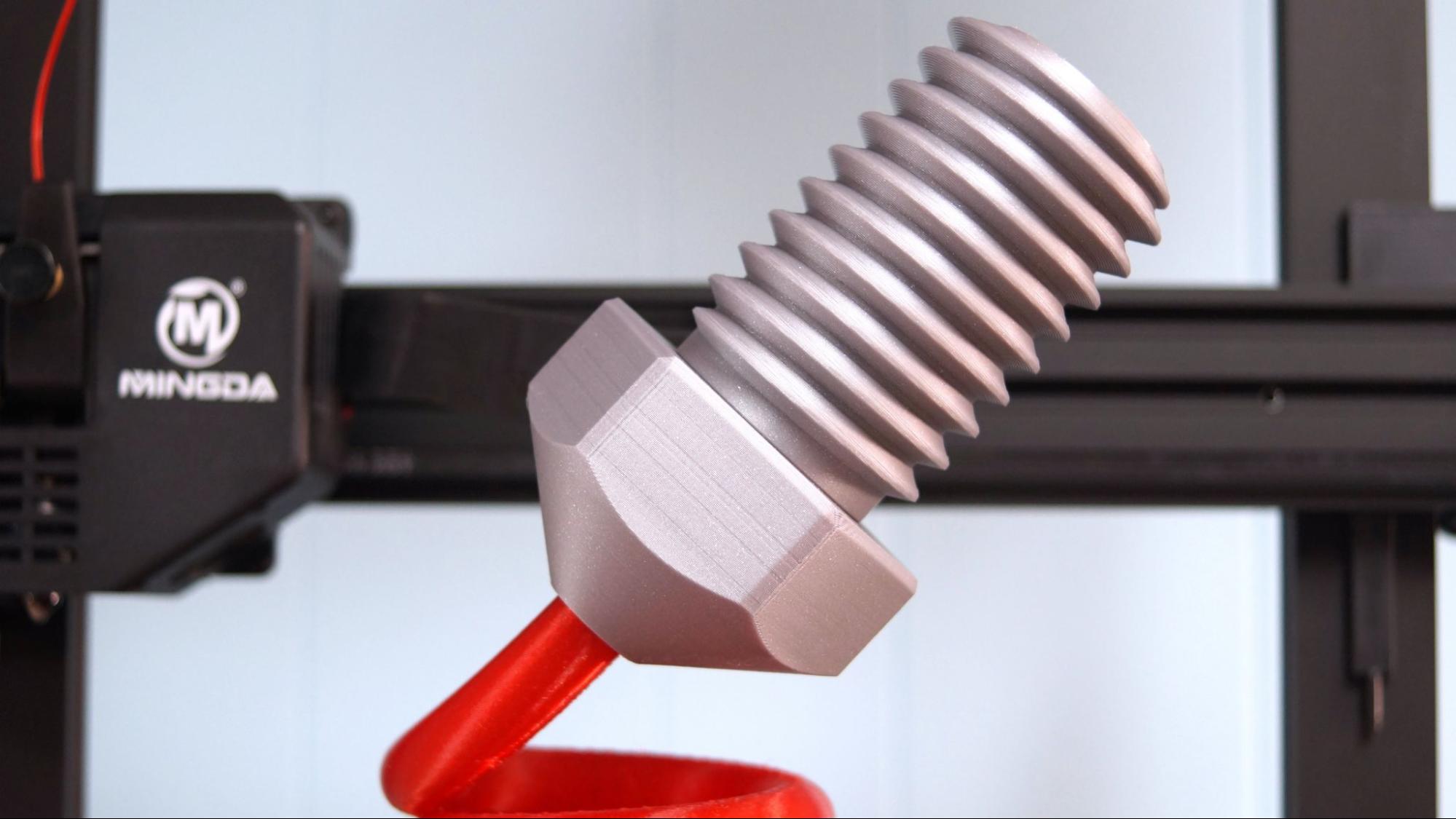
Printception Small Vase by Make Anything, printed on a Mingda Magician Max with Prusament Galaxy Silver PLA.
Prusament is the in-house filament manufactured by Prusa Research, using exacting standards – and lasers – to keep every roll of printer food precise and perfect. They have a large variety of rich colors and several with a glorious dusting of jam free micro glitter. This giant nozzle is dazzling in Galaxy Silver PLA.
Even the spools are well constructed, using an inner recyclable cardboard core and a sturdy plastic outer disk with a handy grove for capturing the tail of your filament. Want to inspect your spool? Each roll has a QR tag that will give you details of how and when it was manufactured. Prusament is manufactured in Prague, Czech Republic.
Buy: Prusament PLA Filament
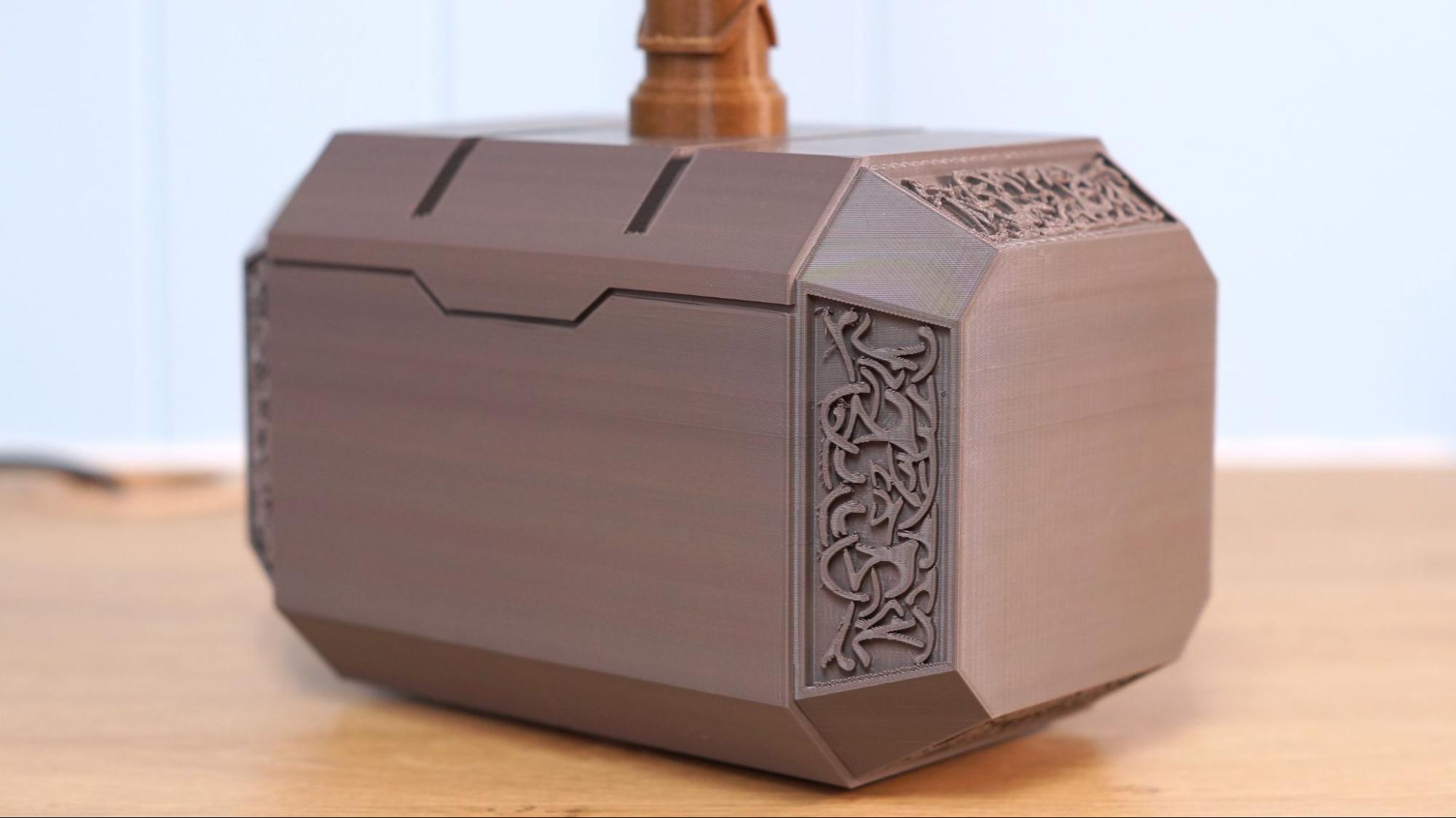
Life Size Thor’s Hammer by ChaosCoreTech, head printed on a FLSun V400 in 3D Fuel ReFuel PLA.
ReFuel is quality recycled PLA filament made from 3D Fuel’s in-house manufacturing waste. Leftover scraps from all their PLA colors are mixed into one giant batch, resulting in spools of brownish gray to earthy black material that looks a bit weird but prints just as wonderfully as the first batch.
The colors can be a bit inconsistent, so ReFuel is best for functional prints or models you intend to paint. Spools are packaged in a plain box with no labels to save on cost. 3D Fuel has factories in both the US and Ireland.
Buy: ReFuel 3D-Fuel Recycled Standard or Pro PLA+ Filament
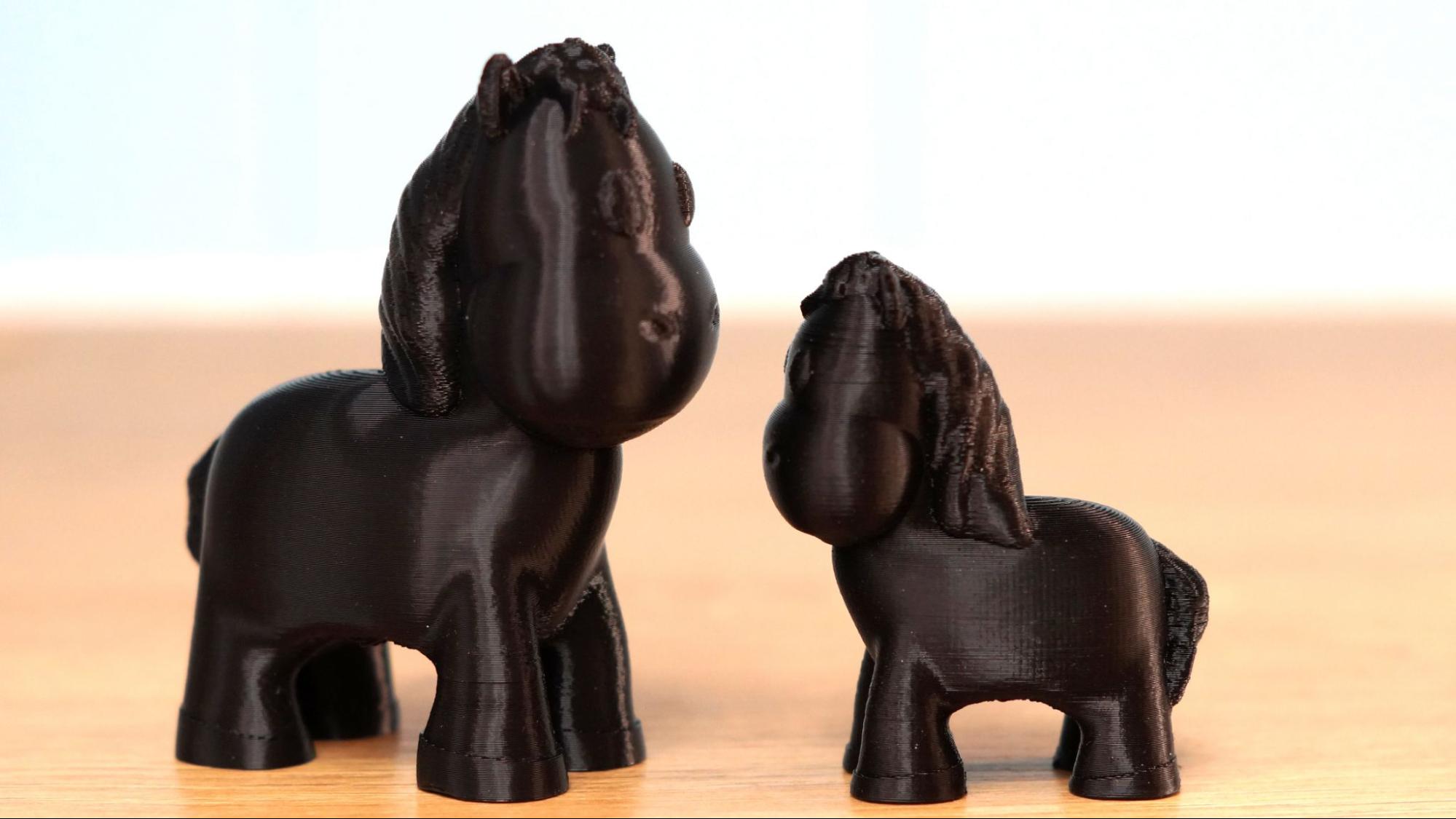
Clyde the Horse by Bugman_140, printed on a CR10s in ProtoPasta Black Recycled PLA.
Would you believe the company known for lux PLA is also the source of the most affordable recycled filament we’ve found? ProtoPasta’s Recycled Black PLA comes from their own manufacturing waste, so every roll of recycled filament is just as smooth printing as ProtoPasta’s first run colors.
Black Recycled is a blend of scraps from their many shades of black and other darker shades mixed together. It’s not considered a heat treatable filament due to the random nature of the mix, but you might find a bit of sparkle in this very rich, dark black PLA. The corrugated cardboard spools are well labeled, but they lack holes for tucking in the tail of filament – we’ve used tape or simply jabbed the end into the edge of the spool. Manufactured in Vancouver, WA.
Buy: Black Recycled PLA Filament
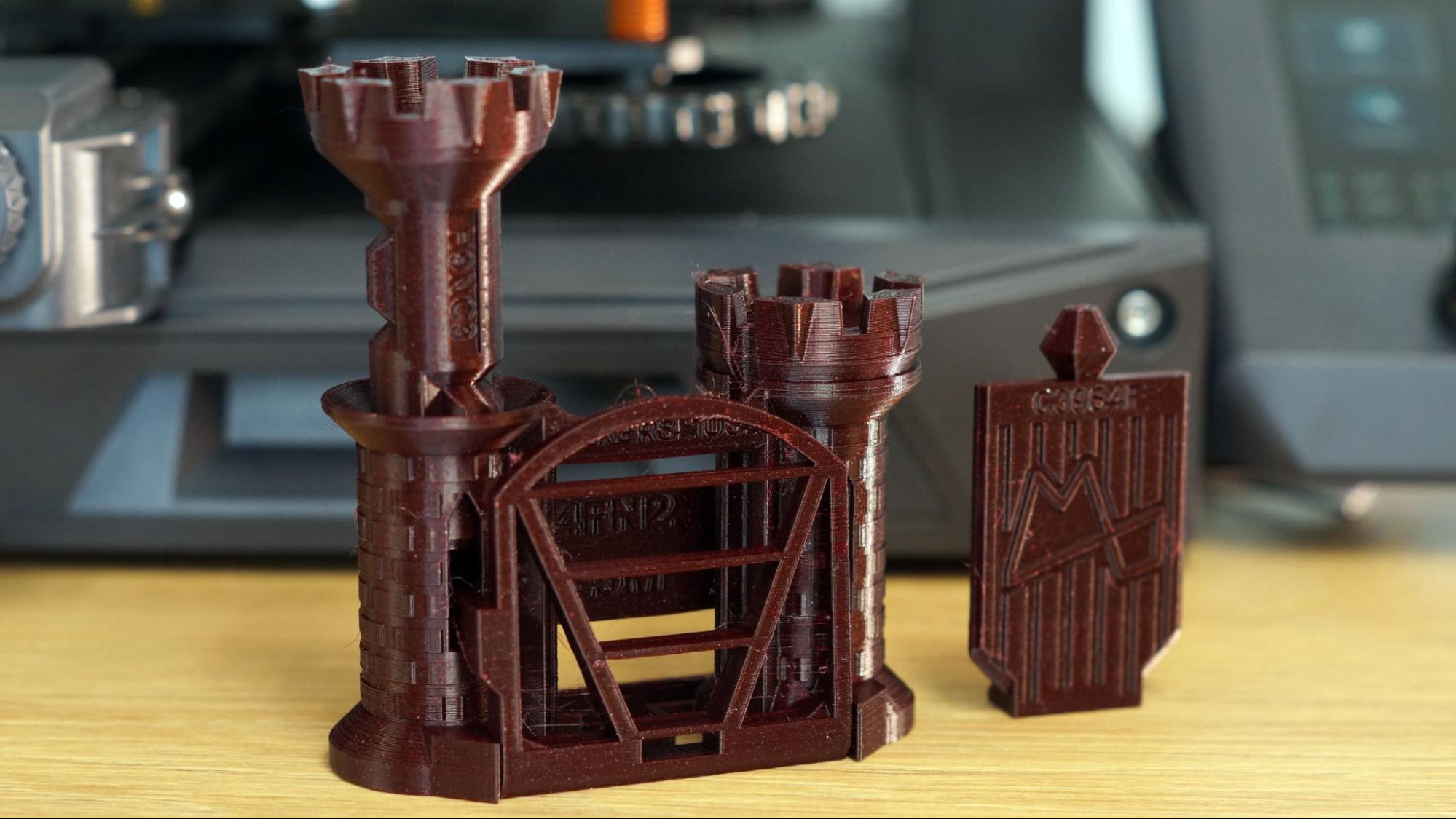
Clearance Castle, by Angus Deveson. Printed on Ender 3 S1 in ProtoPasta Still Colorful Recycled PLA #11.
ProtoPasta’s more colorful line of recycled PLA filament is great for everyday prints with that premium printing experience only ProtoPasta can serve up. The company collects scraps from their own waste stream and keeps it sorted by color group. The clean waste plastics – filament that’s out of spec or color transitions – is ground back into pellets and blended into new recipes with muted colors. The Calibration Castle above was printed in Still Colorful #11.
The results are unique, and the filament has similar print quality to first run materials for a (slightly) discounted price. ProtoPasta’s corrugated cardboard spools are well labeled, but they lack holes for tucking in the tail of filament – we’ve used tape or simply jabbed the end into the edge of the spool.
Buy: Still Colorful Recycled PLA Filament
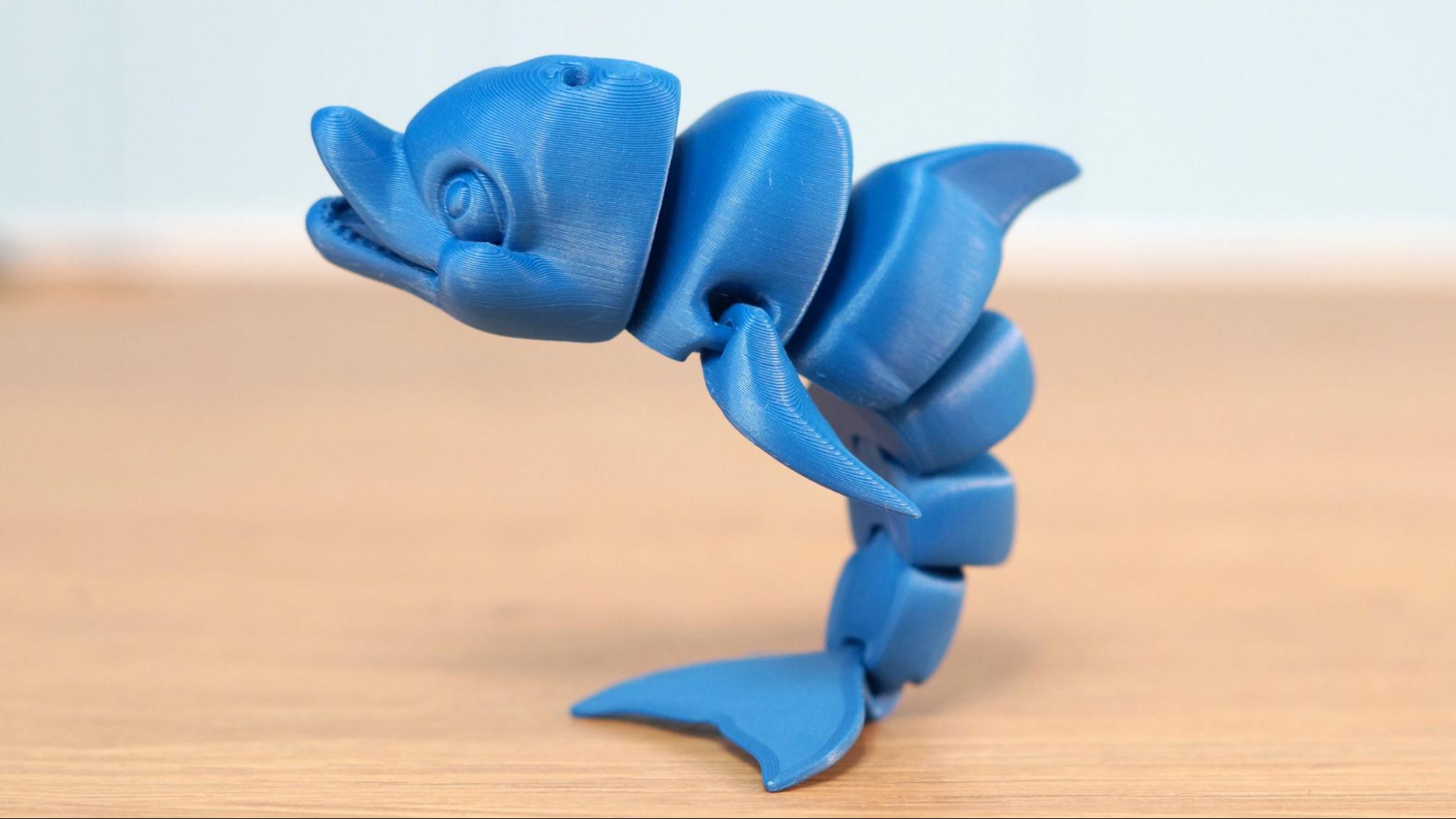
Flexi Dolphin by Flexi Factory, printed on Monoprice Joule in Polymaker PolyTerra Sapphire Blue PLA.
PolyTerra comes in 26 velvety and pastel colors, with a matte finish that does well at hiding layer lines. It’s extremely easy to sand and paint. It’s a good quality, low cost filament for people who want to be environmentally-friendly makers without switching to a recycled filament. The flexi dolphin above was printed in PolyTerra Sapphire Blue PLA.
Many filament companies have switched to cardboard spools to help with recycling, but PolyTerra does one better. Not only is each cardboard spool and package made from recycled material, but PolyMaker contributes to OneTreePlanted.org so that every spool purchased plants a tree in your region. The spools themselves are very sturdy chipboard with well placed holes to help tame the filament’s tail. PolyMaker is a global company with an office and warehouse in Houston, TX.
Buy: PolyTerra Polymaker Matte PLA Filament
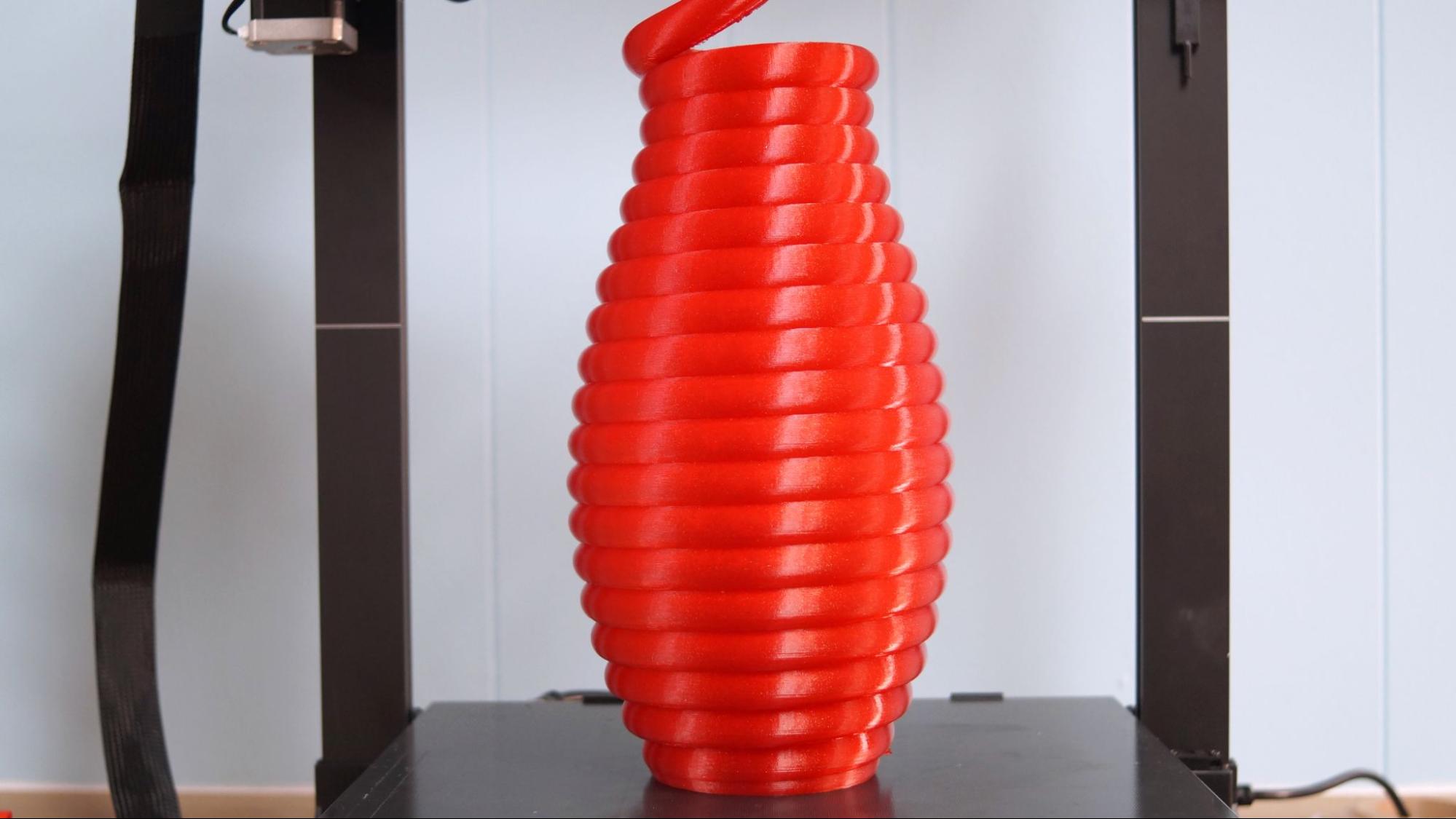
Atomic has 20 super-smooth, translucent PLA colors that deliver a premium printing experience without the premium price tag. Some of Atomic’s colors are scattered with non-abrasive micro glitter or flakes of shimmery pearl for absolutely beautiful results. All the colors print with little stringing or layer lines.
The vase shown here is printed in Golden Blood Diamond, filled with bits of micro glitter. Atomic still uses plastic spools which present a recycling problem when they are used up. The spools are well labeled and have holes to help with containing the ends of your filament. Atomic’s factory is located in Kendallville, IN.
Buy: Atomic Translucent PLA
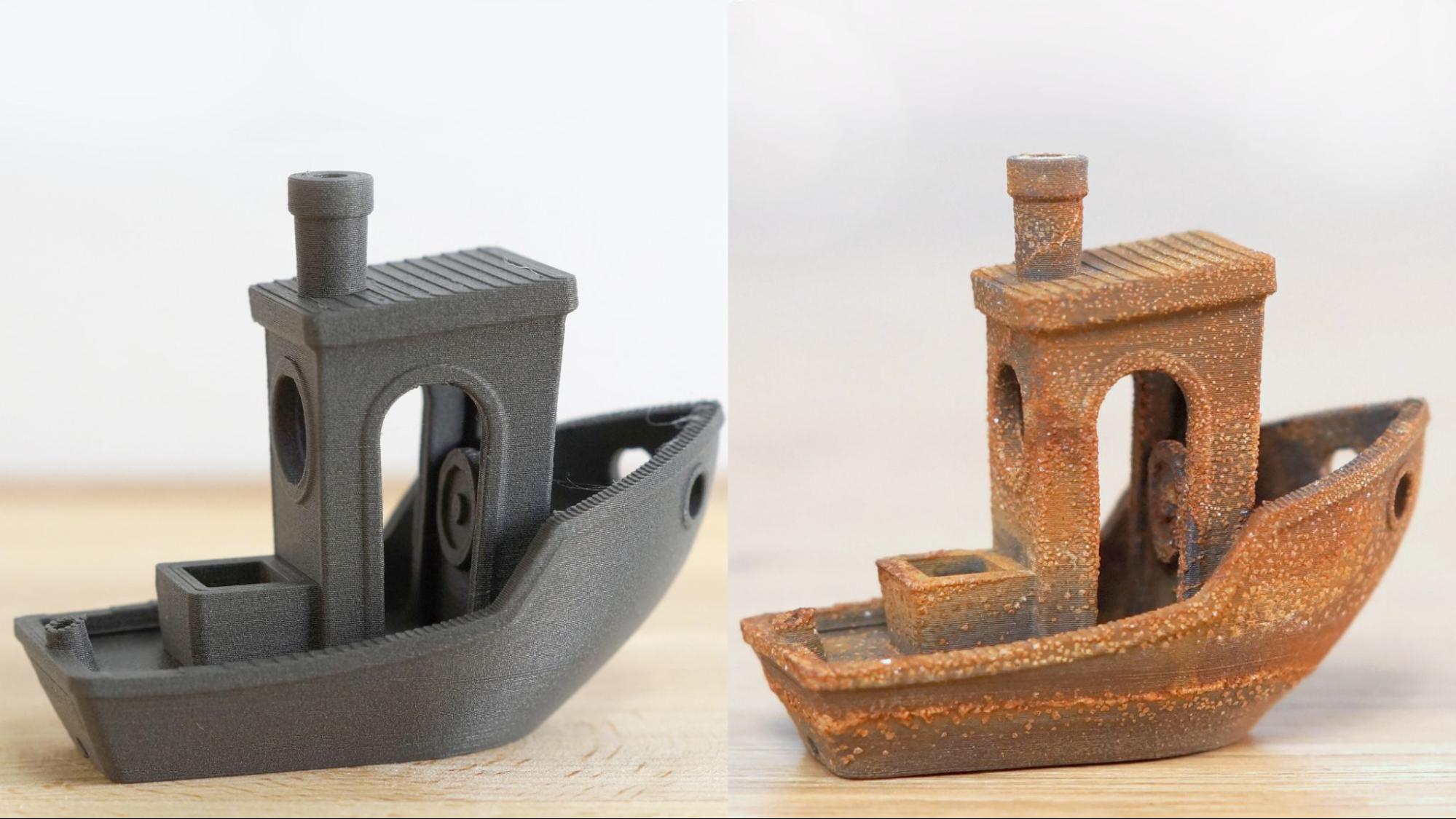
3DBenchy by Creative Tools. Printed on Lulzbot Sidekick 747 in ProtoPasta Iron PLA, untreated and rusted.
ProtoPasta’s metal-filled PLA is a mix of standard PLA mixed with real metal powders. This makes it very abrasive and a bit finicky to print so you’ll need to use a bigger nozzle and slower speed. Iron filled, shown here, is the most affordable of Protopasta’s metal line up. All the metal filaments can be polished to a shine, but iron can be rusted for an old, worn look.
There’s also steel, copper, bronze and brass filaments. Remember to factor in the weight when making your purchase, as filament is sold by weight, not length. These filaments are heavier than straight plastic so you get less filament per spool. This iron Benchy weights 17g, while a pure PLA Benchy weights 12g.
Buy: Protopasta Metal Filled PLA Filament
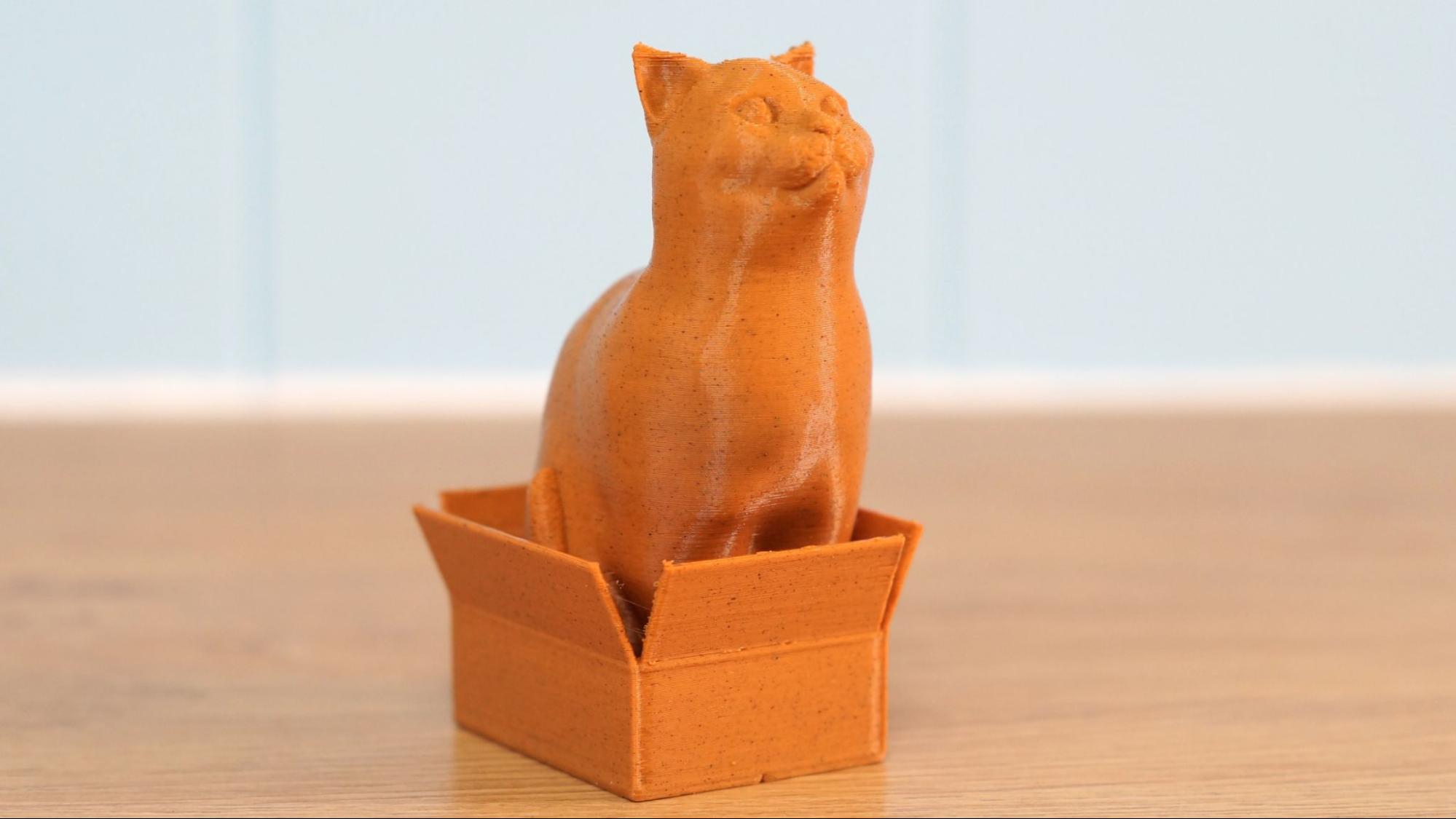
Schrodinky: British Shorthair Cat Sitting in a Box by Loubie3D, printed on a CR10s in 3D Fuel Buzzed Beer PLA.
Buzzed Beer PLA is a fun novelty filament made with 10% organic fibers left over from the beer making process. It has a deep golden brown color with tiny dark flecks, yet is not considered an abrasive filament. It’s great at hiding layer lines, has little stringing, and prints easier than wood based filaments with a similar natural color. We’re calling this one a “novelty” filament because it only uses a small portion of recycled materials, it’s difficult to find in stock and has a premium price.
3D Fuel still uses plastic spools, which is inconvenient once the filament is used up. They are well labeled and have good spots for managing the filament tails. 3D Fuel has factories in both the US and Ireland.
Buy: 3D Fuel Buzzed Beer PLA Filament
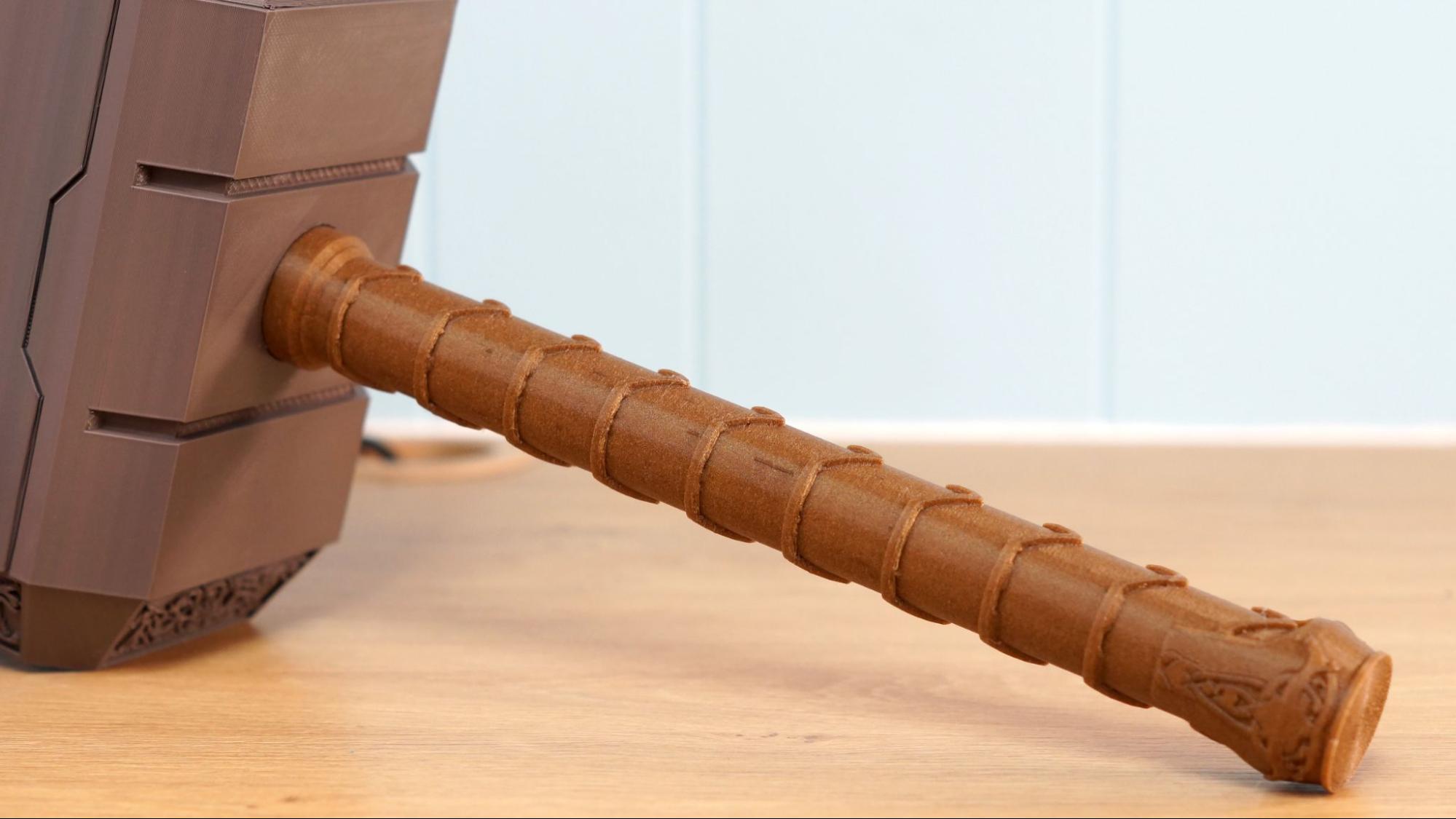
Life Size Thor’s Hammer by ChaosCoreTech, handled printed on a FLSun V400 in 3D Fuel Entwined Hemp PLA.
Entwined is a beautiful filament with a natural, almost translucent, earthy wood tone derived from hemp. It’s premium PLA mixed with natural hemp fibers that prints with less noticeable layer lines and little stringing. We’re placing this one in the “novelty” category because it only uses a small portion of recycled hemp fiber, it’s difficult to find in stock and has a premium price. It does, however, print really well and makes a smoother printing alternative to wood PLAs.
3D Fuel still uses plastic spools, which is inconvenient once the filament is used up. They are well-labeled and have good spots for managing the filament tails. 3D Fuel has factories in both the US and Ireland.
Buy: 3D Fuel Entwined Hemp PLA Filament
Best PETG Filaments
PETG (Polyethylene Terephthalate glycol) is an oil based plastic that’s less brittle than PLA. It’s more resistant to high temperatures and sunlight, making it more suitable for outdoor parts or prints used inside a car. It’s easier to recycle than PLA, resulting in many brands of 100% or partially recycled PETG filament.
It can be a little harder to print than PLA, is often stringy, and is more difficult to sand and paint. For best results, PETG should be kept in a sealed bag or airtight box to reduce moisture exposure.
PETG can be printed with any 3D printer, any bed surface and does not require an enclosure. It does print hotter than PLA, but not so much as to require an all-metal hotend. PETG will bond with glass and sticks entirely too well to PEI coated print surfaces. You will need to use a layer of gluestick as a release agent – which is somewhat counterintuitive, but definitely works.
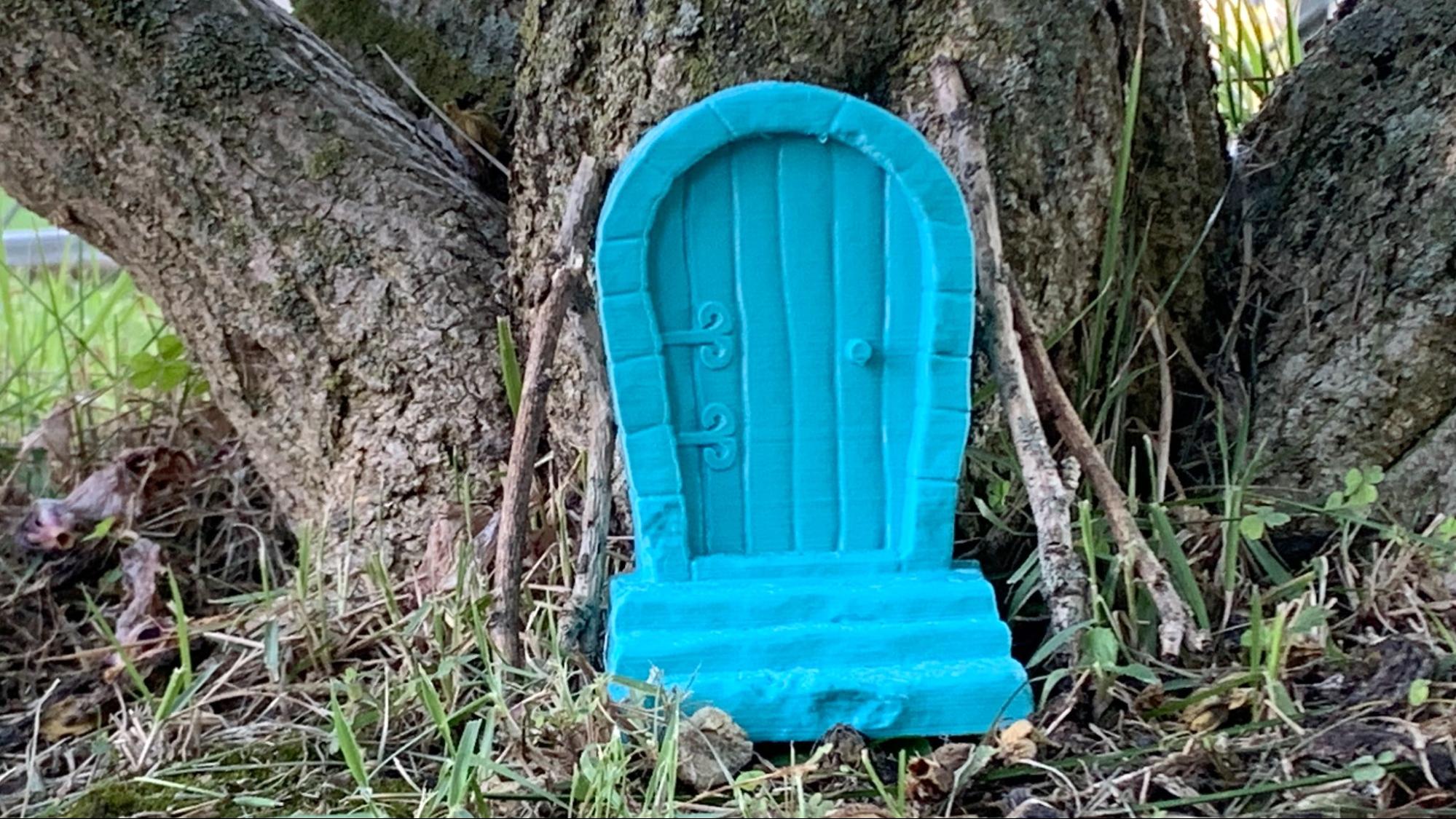
Fairy Door by Jukka Seppanen, printed on the Mingda Magician Max in PolyMaker PolyLite Teal PLA.
Easy to print with just a tiny wisp of strings, PolyLite is wonderful for creating stronger 3D prints. This Teal fairy door will be hidden along a trail without any fear of fading or melting. There are many solid colors to choose from, as well as a few translucent shades. The spools themselves are very sturdy chipboard with well-placed holes to help tame the filament’s tail.
There’s even a window in the side and a gauge to help determine how much filament is left. PolyMaker is a global company with an office and warehouse in Houston, TX.
Buy: PolyMaker PolyLite PETG Filament
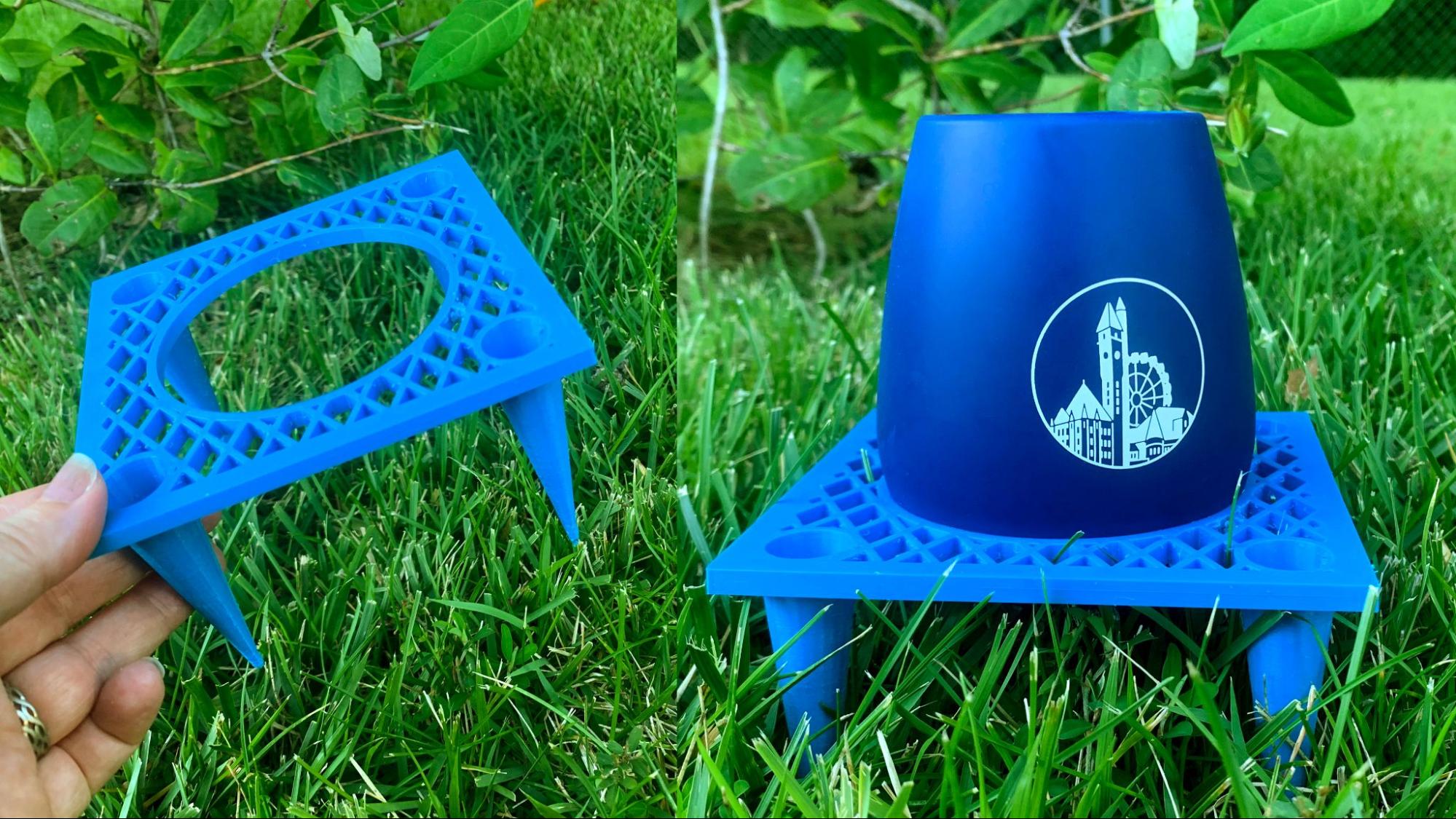
Picnic Festival Glass Holder by PM_Me_Your_Value, printed on an Ender 3 Pro with Jessie Premium Pure Cyan PETG.
Bargain hunters rejoice – Jessie by Printed Solid now comes in PETG. As with its line of in-house manufactured PLA, Jessie PETG offers 13 bold opaque colors that print without trouble or much stringing. Shown above is PETG Pure Cyan. Spools are well labeled and made of sturdy chipboard with a steel core that helps lower friction while still being fully recyclable. Jessie filament, named after the CEO’s dog, is manufactured in Newark, DE.
Buy: Jessie Premium PETG Filament
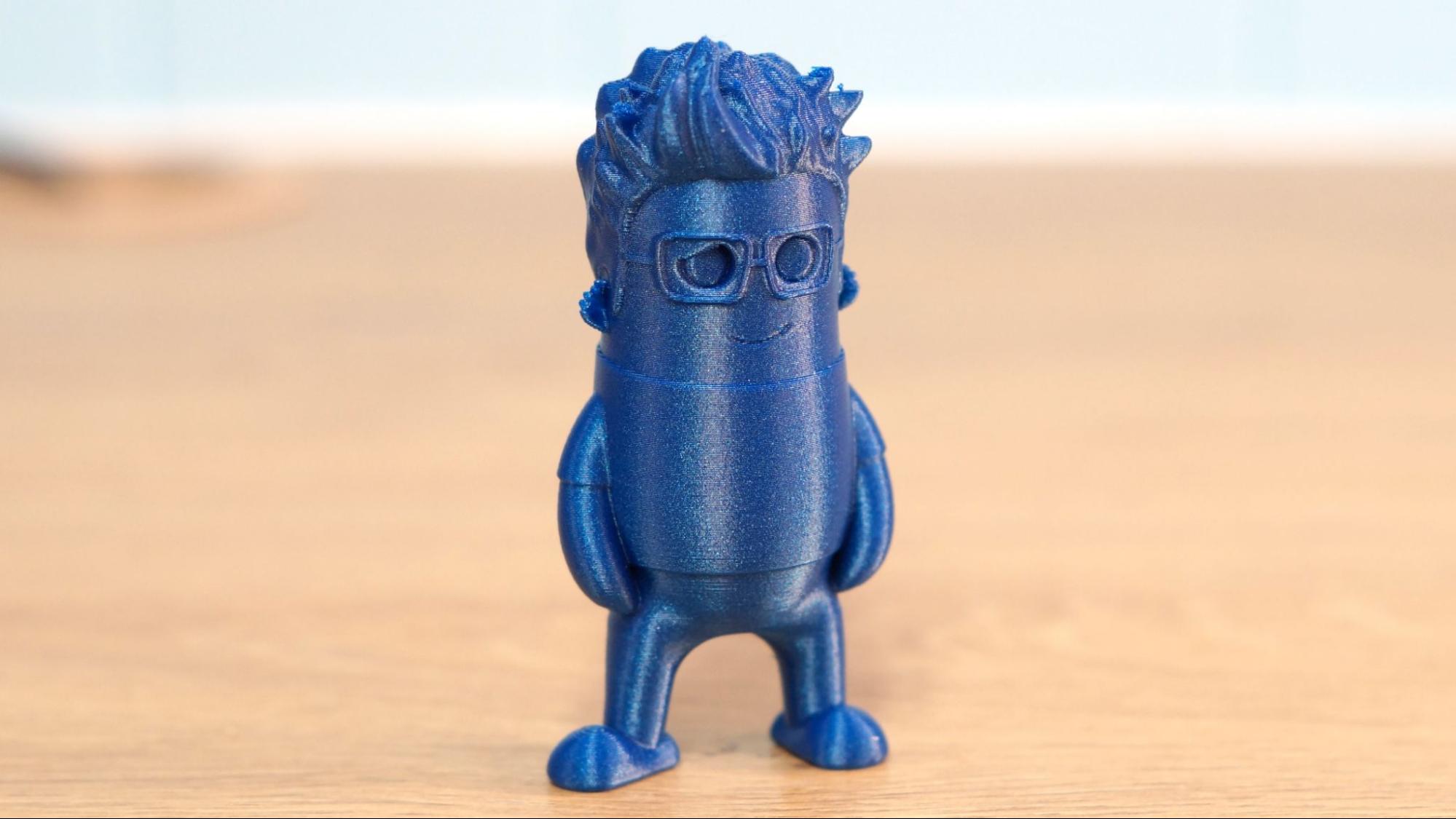
Protopasta has been recreating their most popular HTPLA colors in PETG, using 75% recycled material. Shown above is Galactic Empire Metallic Purple. Currently showcasing nine colors, the PETG filaments are easy to print, hide layer lines well and have very little stringing. Fun fact: this Mini Joel printed in PETG Highfive Blue looks exactly like one I printed in Highfive Blue PLA.
The cardboard spools are well labeled, but they lack holes for tucking in the tail of filament – we’ve used tape or simply jabbed the end into the spaces in the corrugated cardboard. They’re manufactured in Vancouver, WA.
Buy: Protopasta PETG Filament
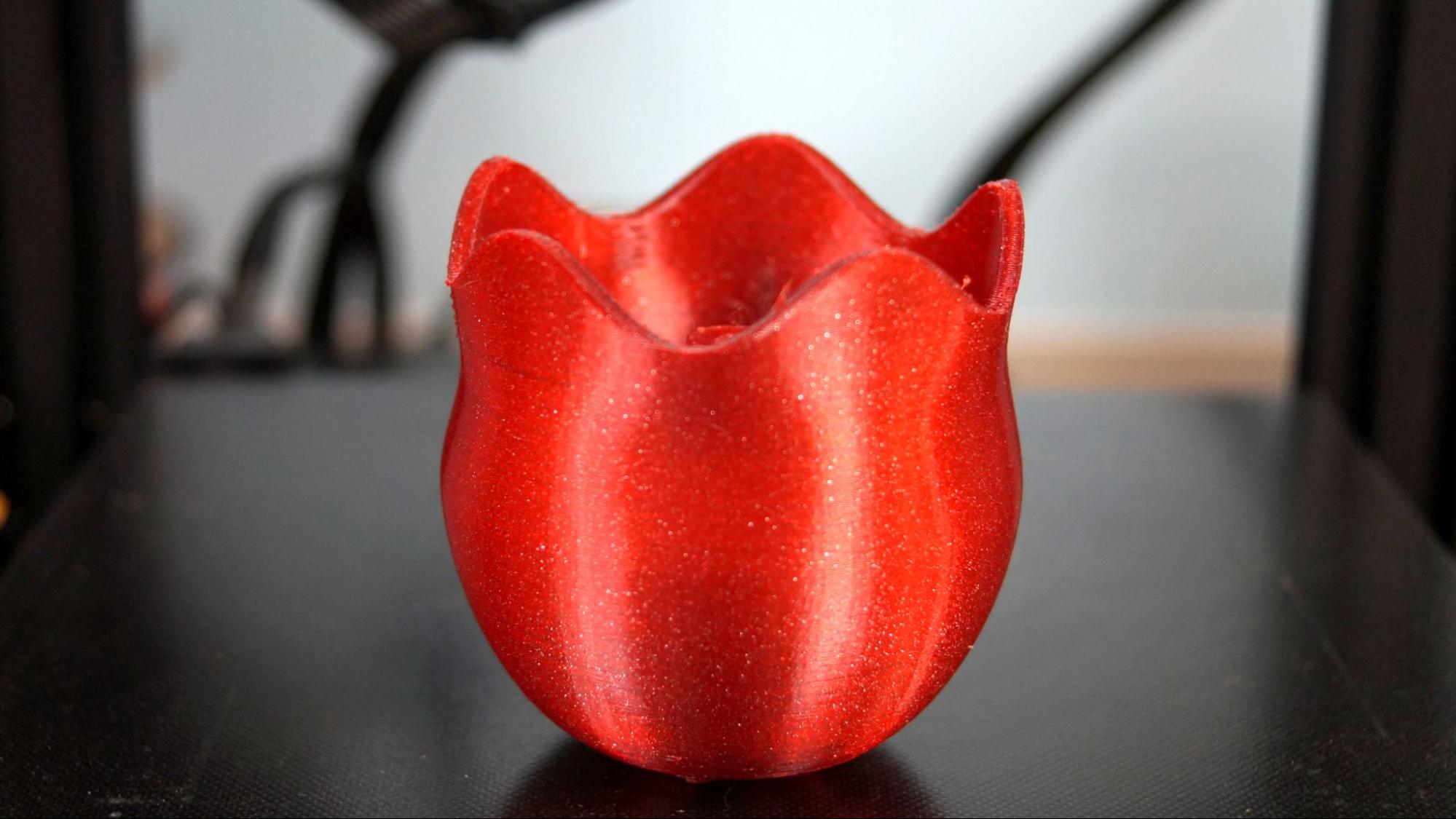
Ant Moat by wkarraker, printed on a Monoprice Joule in Prusament Carmine Red Transparent PETG.
Prusament filaments are known for their exacting standards and high quality control, so it’s no wonder their PETG prints with little fuss and few strings. Shown here is Carmine Red Transparent, one of 20 colors in the PETG line.
Prusa’s eye for details goes down to the spools, which use an inner recyclable cardboard core and a sturdy plastic outer disk with a handy grove for capturing the tail of your filament. Want to inspect your spool? Each roll has a QR tag that will give you details of how and when it was manufactured. Prusament is manufactured in Prague, Czech Republic.
Buy: Prusament PETG Filament
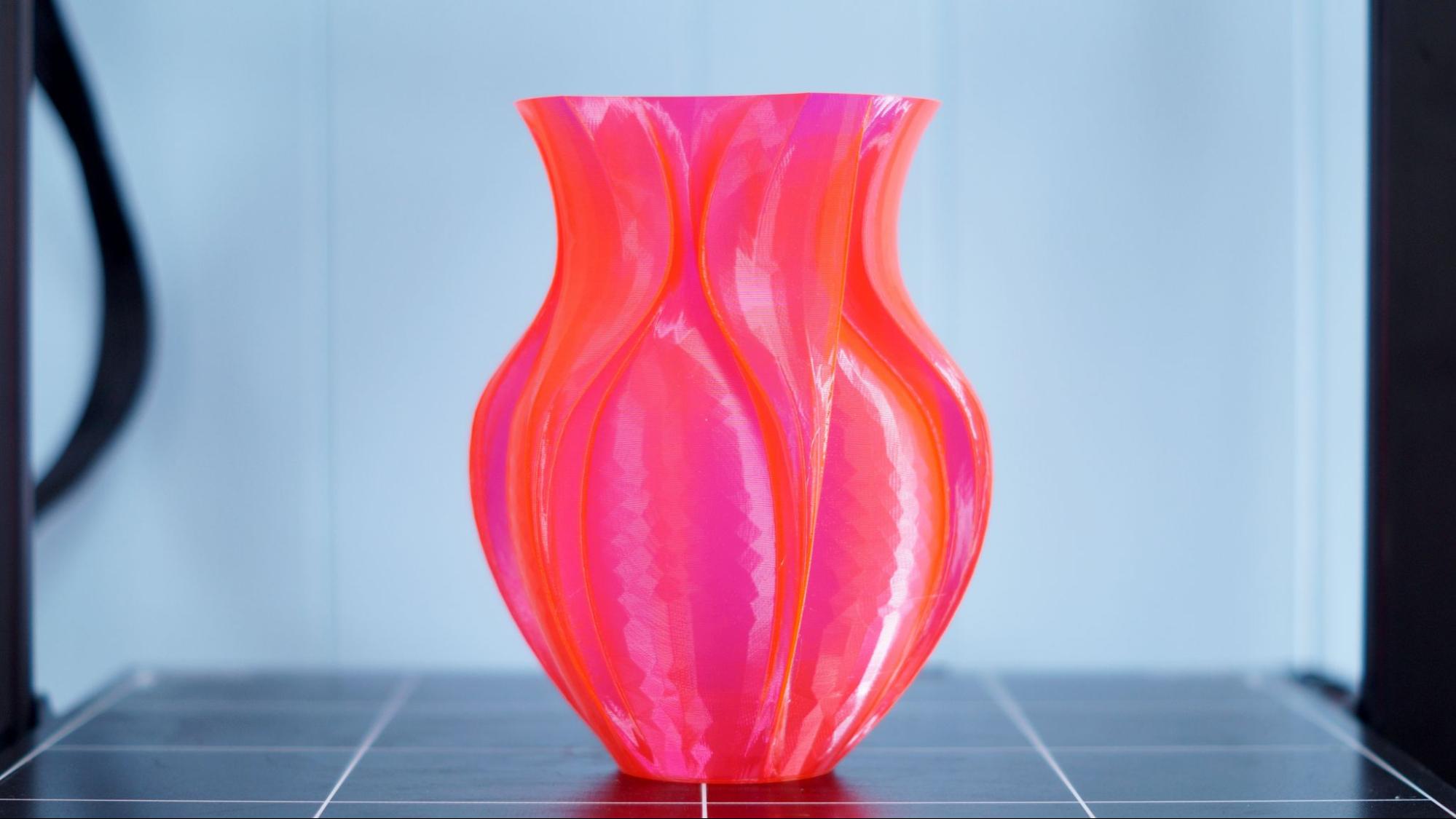
Curvy Vase, by Monomethylhydrazine, printed on a Kobra Max in KVP Edge Glow Pink PETG.
Edge Glow PETG is a smooth transparent filament with glass-like qualities with excellent results. It’s easy to print with few strings, perfect for decorative objects, vases or very pretty practical prints. This vase is printed in Edge Glow Pink.
Keene Village still delivers materials on plastic spools and uses an odd tracking code on their labels that’s difficult to decipher. The overly simple labeling is probably because KVP is a white label manufacturer that produces filament for other companies as well as their own end use customers. KVP is manufactured in Euclid, OH.
Buy: KVP Edge Glow PETG Filament
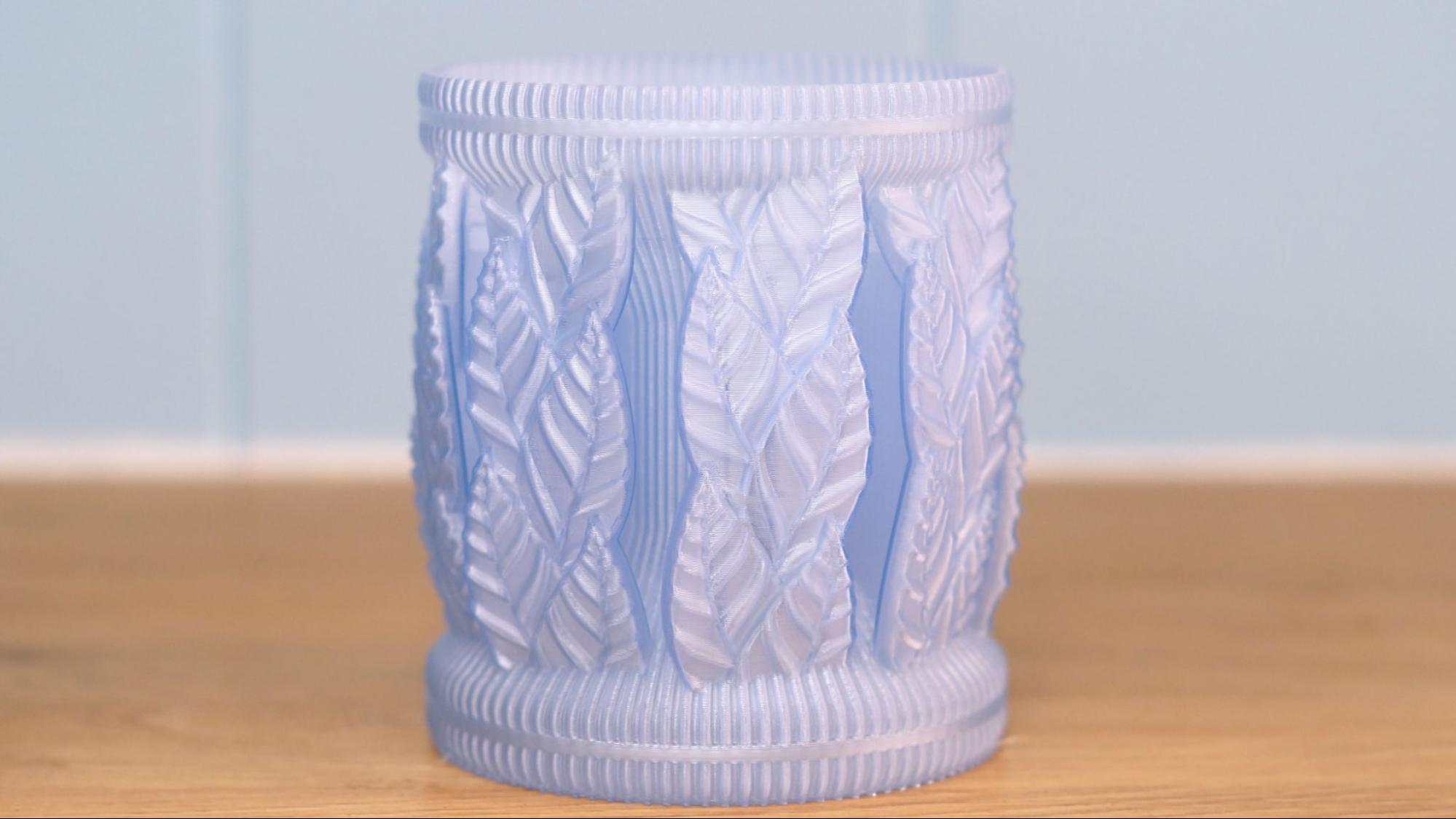
Arboreal Vase by Clockspring, printed on a Lulzbot Sidekick 747 In Taulman3D Enviro Aqua PETG.
Taulman3D PETG is made from 100% recycled materials on 100% recycled cardboard spools that are well labeled with easy to use spots for taming filament tails. Taulman3D is best known for their tough engineering grade materials – they don’t even have a line of PLA. Enviro PETG comes in 6 solid colors and the clear aqua as shown. Taulman Enviro PETG is available on Amazon, and manufactured in Missouri.
Buy: taulman3D PETG Recycled Filament
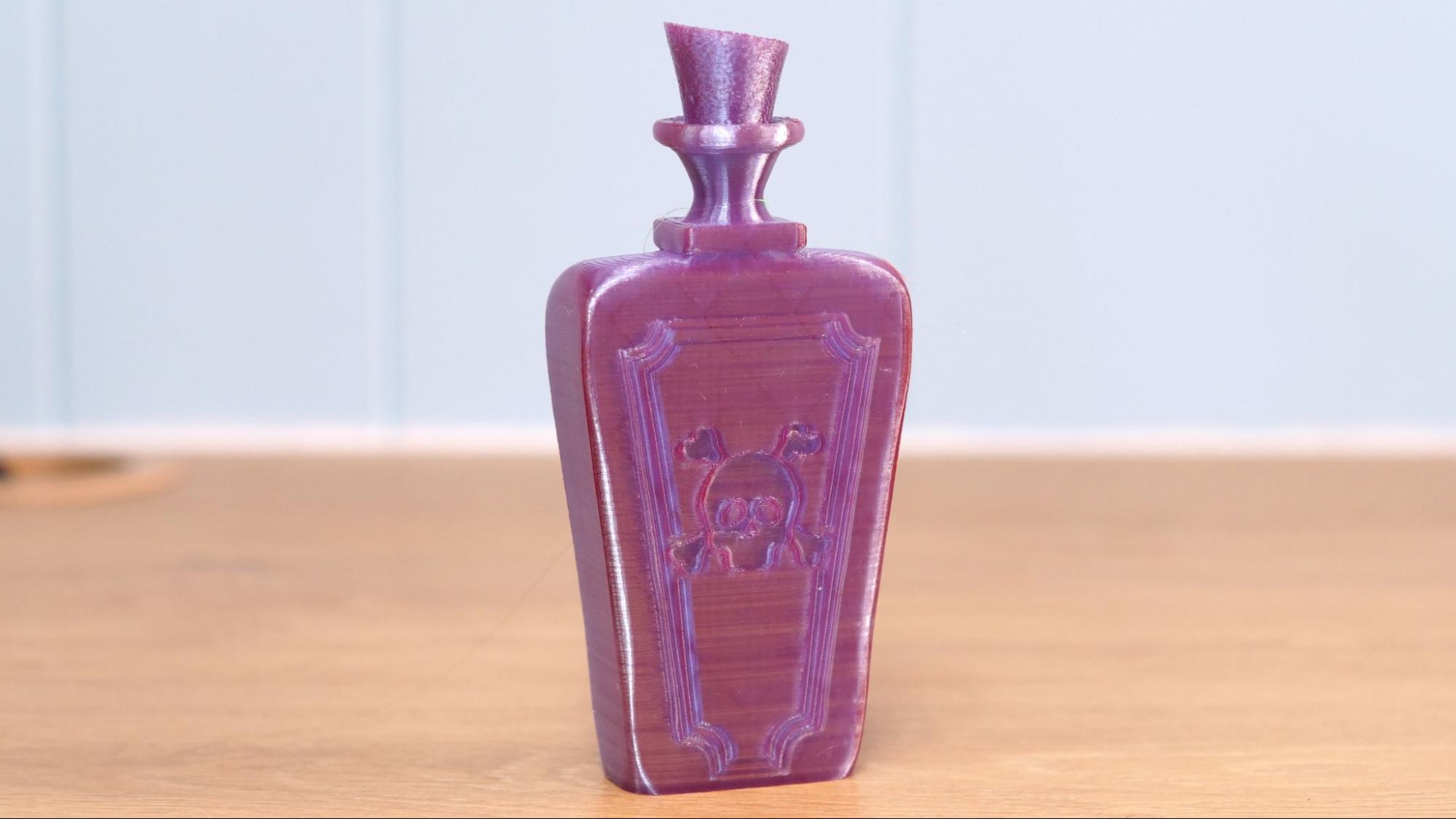
Poison Bottle by ChaosCoreTech, printed on a Monoprice Joule in Greengate Purple Reign PETG.
Greengate only makes one thing: fantastic 100% recycled PETG. Greengate knows recycling – the owners also run a plastics recycling company in New York and started their filament company as a way of keeping industrial waste out of the landfills.
They have 32 colors in both translucent and opaque. Shown above is Purple Reign, a premium iridescent PETG. Though Greengate uses well labeled plastic spools, they do make an effort to recycle by collecting customer empties for reuse.
Buy: Greengate 3D PETG Filament
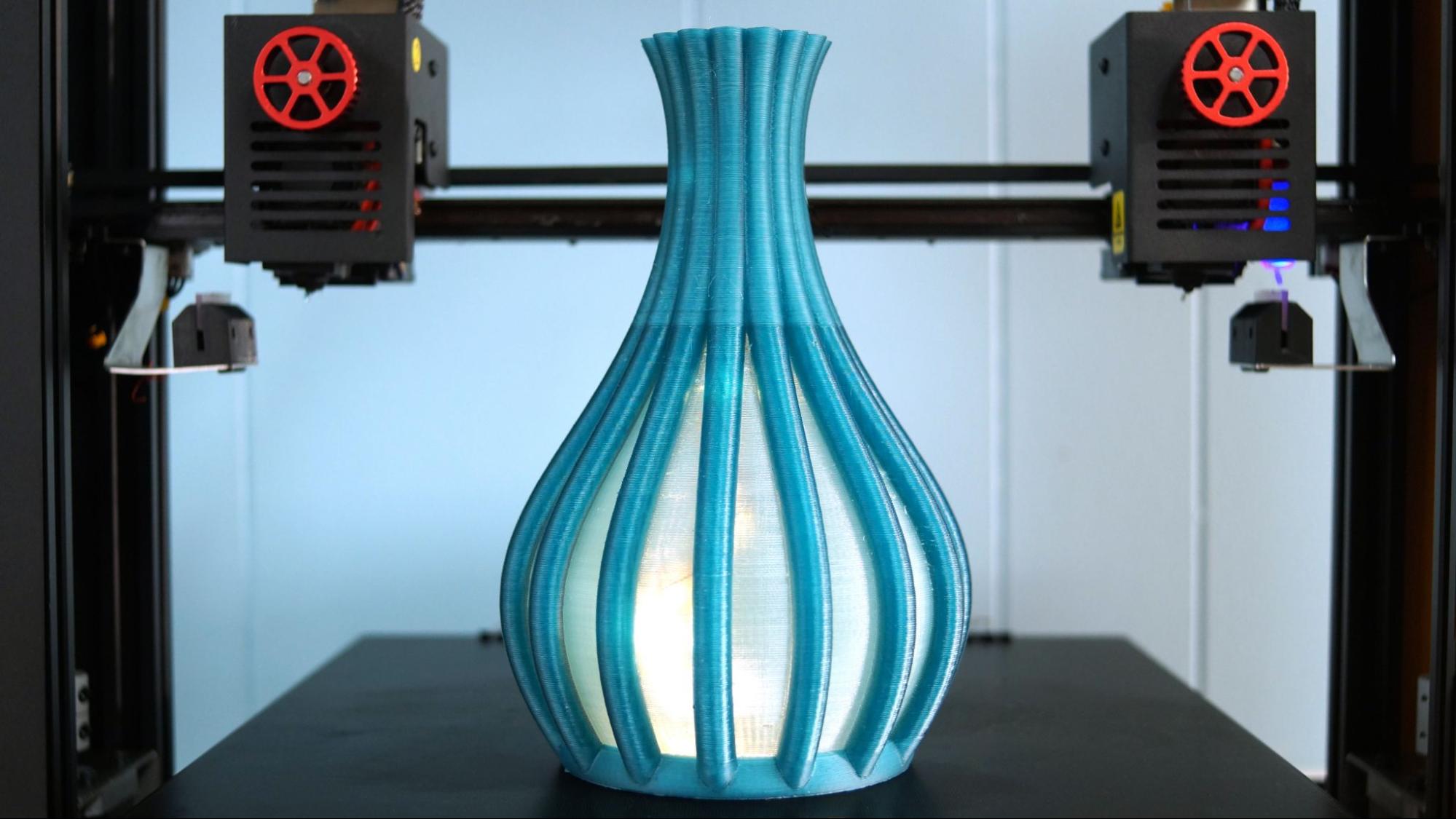
Princess Vase by Abby Math, printed on a Kywood3D Tycoon IDEX in IC3D Translucent Blue Razz R-PETG and KV Edge Glow Glass PETG.
IC3D line of recycled PETG is strong enough for functional prints and pretty enough for decorations. It prints consistently with very little stringing – though the level of cooling can alter the color of the print as seen in the Blue Razz vase above. This 100% recycled PETG is made from industrial and commercial wastes, creating a second life for plastics. IC3D reuses plastic spools collected from the community. You can buy IC3D R-PETG direct, at your local Micro Center or through Printed Solid. IC3D is manufactured in Columbus, OH.
Buy: IC3D R-PETG Filament
Best TPU Filaments
Whether you’re making toys that can withstand hard play or functional prints that take a beating, TPU (Thermoplastic Polyurethane) is a great choice. TPU isn’t brittle like PLA and has a rubberlike quality that makes for good handles, phone cases and even gaskets. You can make your parts softer or harder by adjusting the number of walls and level of infill – 10% infill for squishy prints or 50% infill for firm rubbery prints. It’s also not as UV sensitive and can be used for outdoor parts.
TPU is an extremely soft filament that works best with a direct drive printer. Using a Bowden style extruder is not impossible, but it is much like pushing a wet noodle into your hotend. It needs to print at a higher temperature than PLA, but doesn’t need an all metal hotend or enclosure. Any bed surface will work with TPU, but you will find a layer of glue stick to be helpful for removing prints.
TPU also needs a slower printing speed and very little retraction. Stringing is almost unavoidable, so it’s best to keep this filament very dry and avoid models with a lot of travel moves.
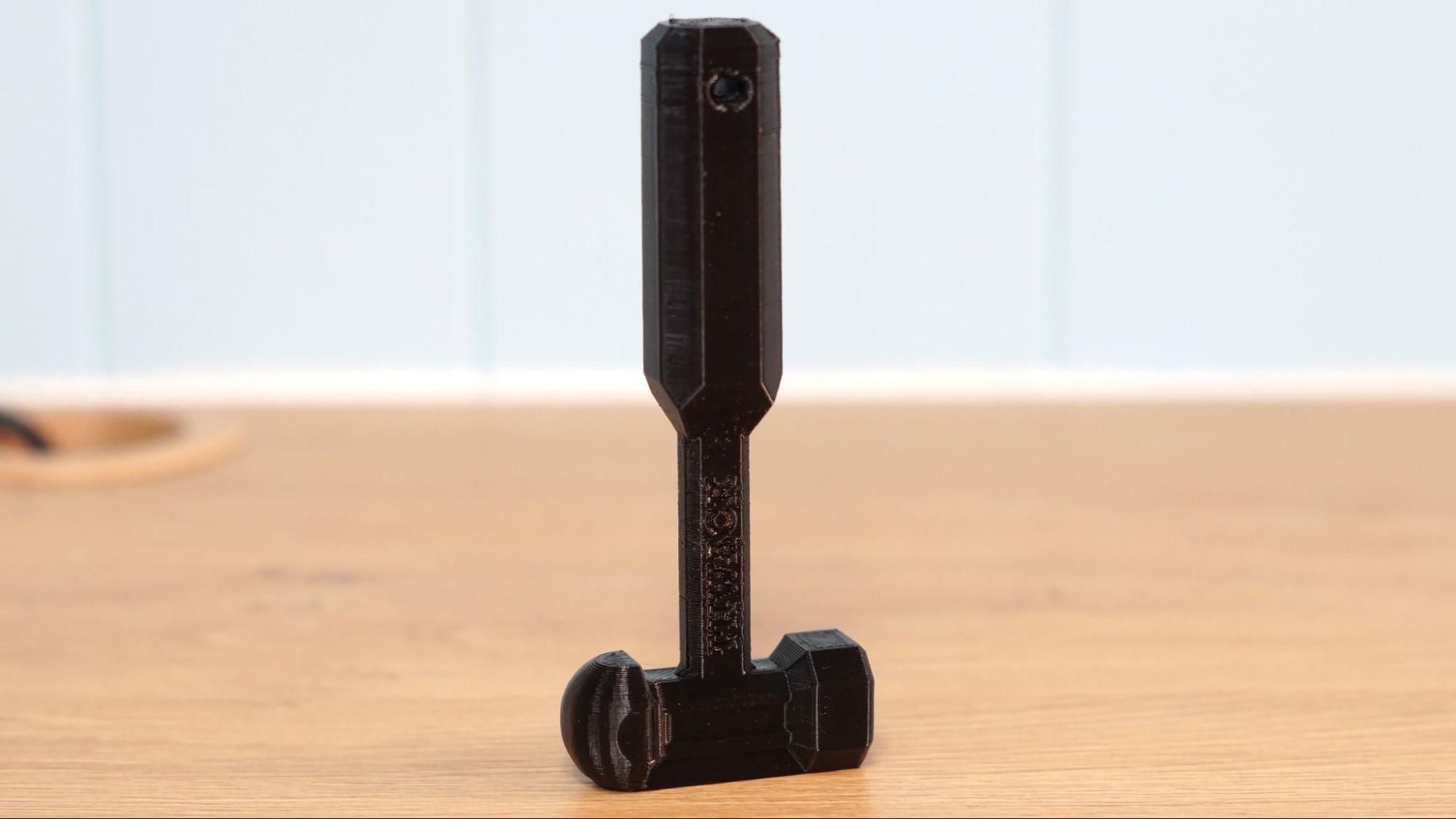
Thwack! V3 by low351, printed on a Lulzbot Sidekick 747 in Inland Black TPU.
Inland’s line of TPU is strong, stretchy and the best bargain we’ve found on flexible filament. It comes in several crystal like colors, but the company’s Amazon shop is limited to a boring selection of white, black and gray (you can find more colors at Micro Center). Shown above is Black TPU.
Its shore hardness is typical for TPU at 95A, meaning it is soft and flexible like a flip-flop or perhaps a tire. Of course this all depends on how thick you make the walls and infill. Our sample print used 2 walls and 10% infill, turning the Thwack Hammer into more of a Clown Hammer.
Buy: Inland TPU Filament
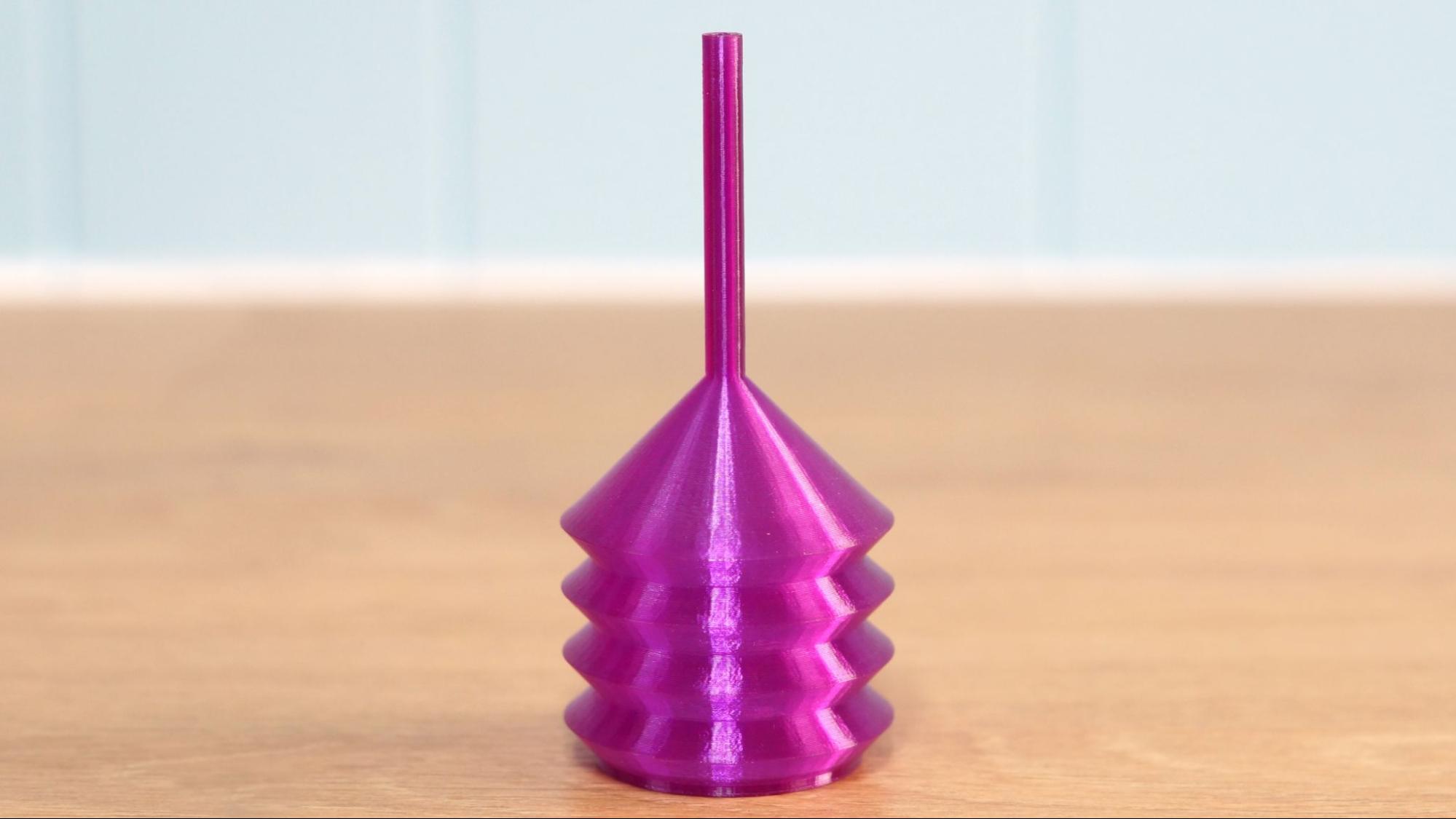
TPU Air Duster, printed on a Sovol SV01Pro in MH Build Translucent Purple TPU.
MH Build TPU is a stretchy TPU with a shore hardness of 95A – soft and flexible. We’ve made great flexi toys with it, but the functional thin walled air duster shown above in Translucent Purple is a favorite. Matterhackers’ translucent TPUs are shiny and sparkly, which means anything you print with them will be fun to look at ask well as play with. We’ve made a fantastic phone case with it and yes – the phone has survived several drops.
Buy: MH Build Series TPU Filament
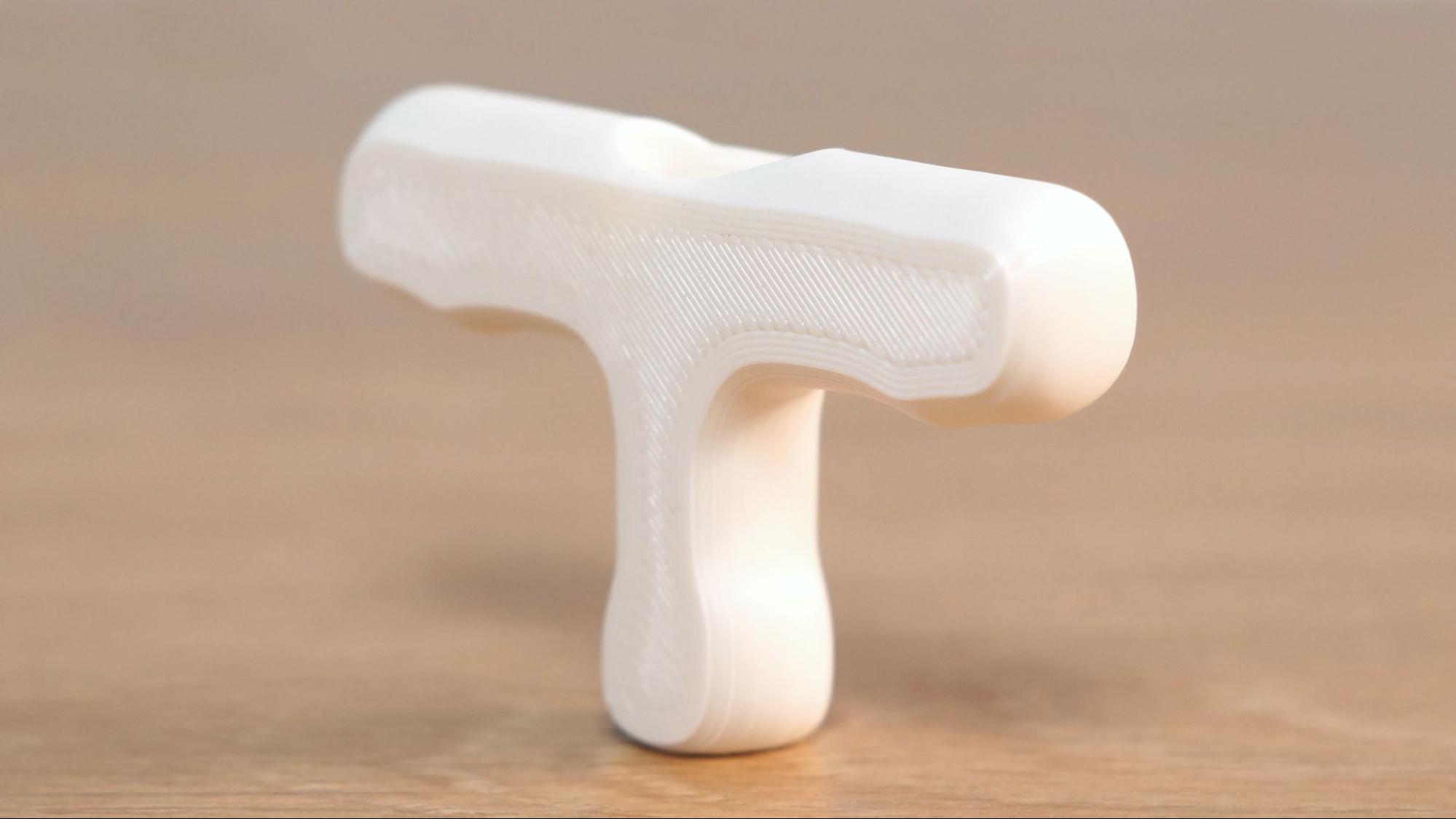
Pull Start Handle by Copper Keep, printed on a Lulzbot Sidekick 747 in KV Vexi-Flexx70 White TPU.
Vexi-Flexx70 is a super tough flexible filament that can make durable functional prints. Unlike ordinary TPU, Vexi-Flexx70 has a Shore hardness of 70D, making it similar to very hard rubber.
When printed with a dense infill you get extremely sturdy parts that won’t break when tossed around. The samples we made, like this white handle for a lawnmower, are very hard without any sponginess. Like most TPU, it works best with a direct drive printer. It’s still prone to stringing, our handle looks wonderful and smooth because there were no travel moves.
Buy: Vexi-Flexx70 TPU Filament
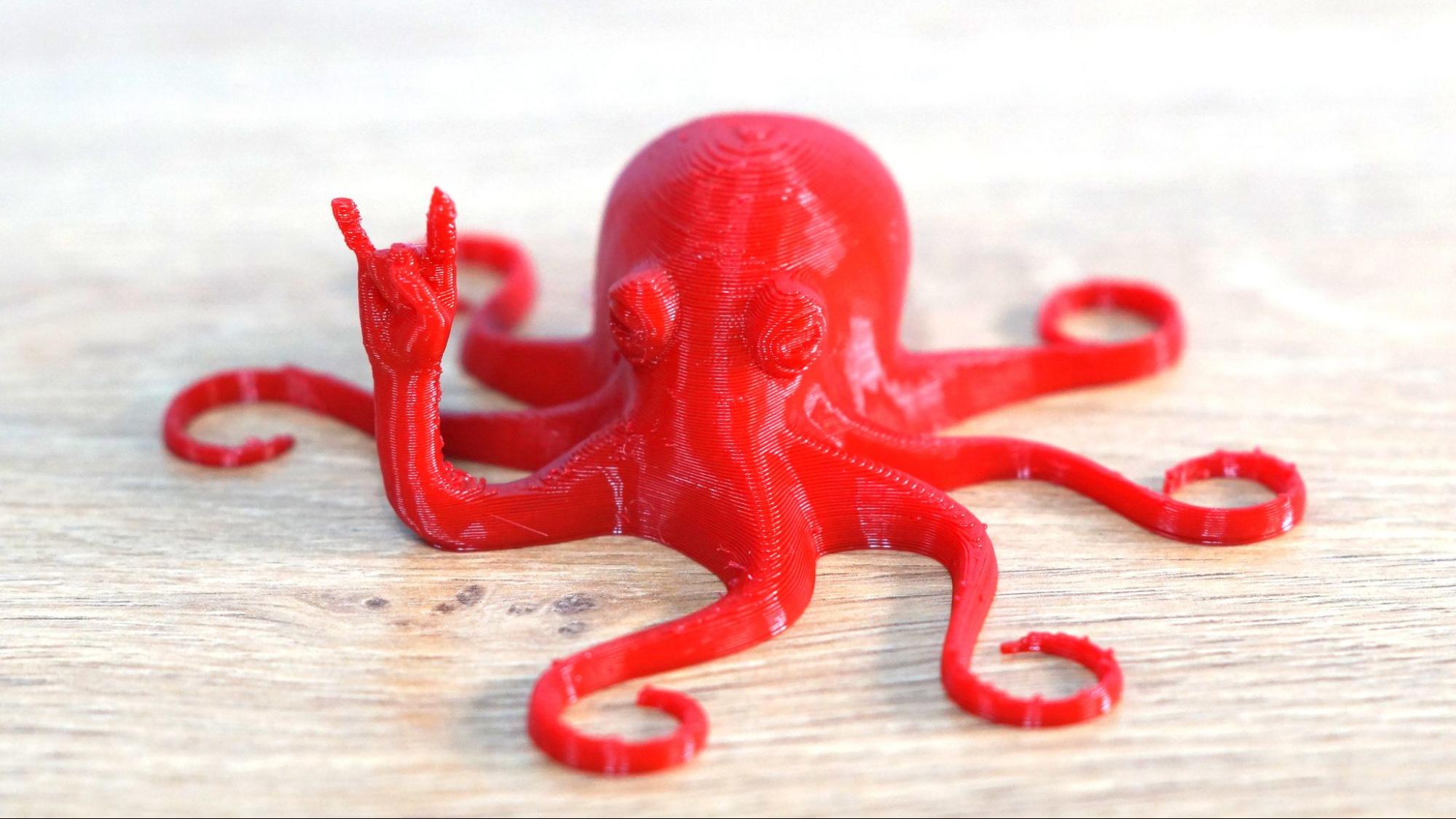
Rocktopus by Kent Johnson, printed on a Lulzbot Sidekick 747 in NinjaTek Fire Red Cheetah TPU.
Cheetah TPU has a shore hardness of 95A making it very soft and flexible, yet NinjaTek claims it can print twice as fast as normal TPU. Hence, the Cheetah moniker. We tried running it at 60mms – as suggested by their website – and only got jams, even with a direct drive.
Slow and steady is still the way to go when you’re printing filament with the properties of a wet noodle. Our Fire Red OG Rocktopus was run at a more conservative 40 mms and turned out pretty nice with a little stringing that was easily trimmed off.
Buy: NinjaTek Cheetah TPU Filament
MORE: How to Store 3D Printer Filament and Keep it Dry
MORE: How to Buy the Right 3D Printer
MORE: Best 3D Printers
MORE: Best Budget 3D Printers
